Moss and mammoths (part 2)
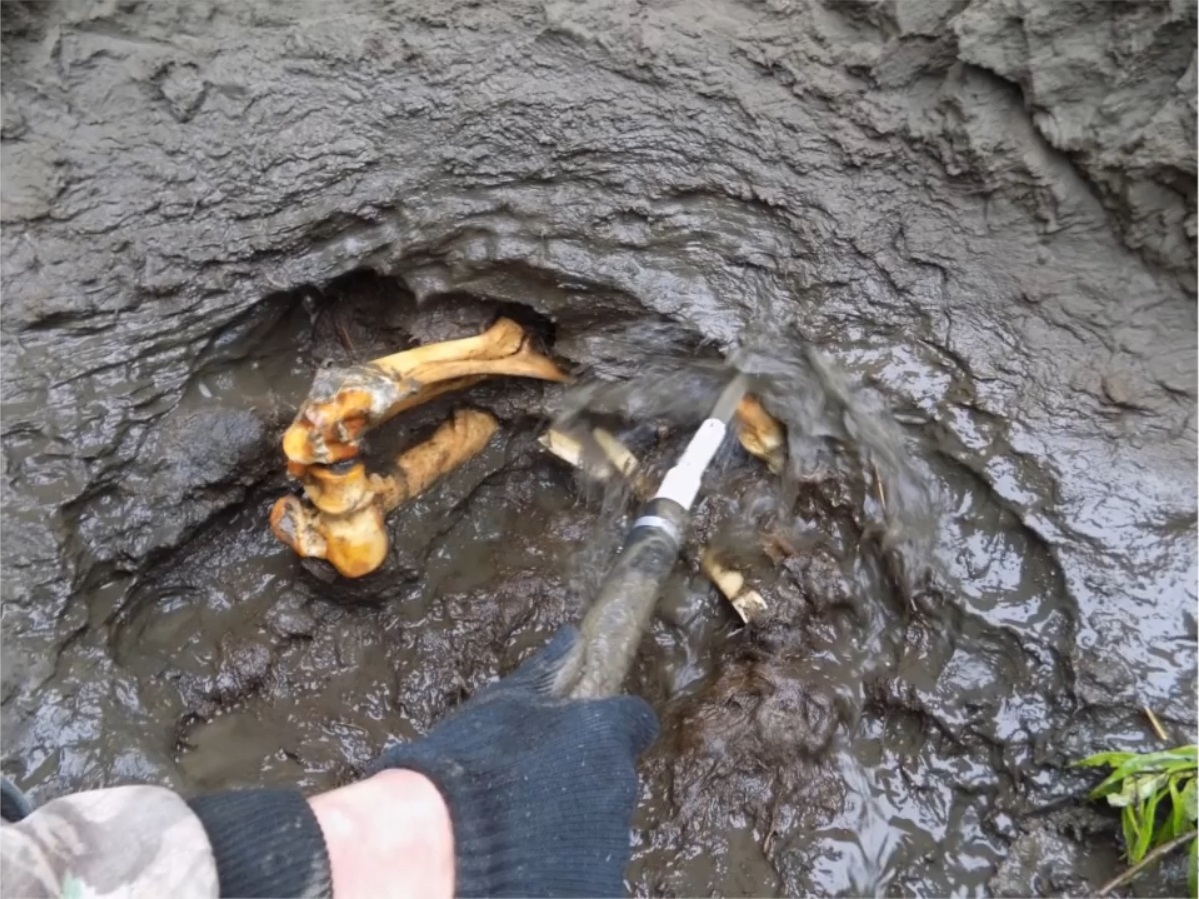
About how permafrost can become, if not “a white fur-bearing animal”, then certainly a “black swan” that has concealed one and a half trillion tons of carbon, we read the first part of “Moss and Mammoths” .
About how you can stop the thawing of permafrost, turn the northern latitudes into a highly productive steppe with the help of shaggy four-legged comrades and about the "alternative" model of the planetary ecosystem - we read / look under the cat.
The nature that we see today on the planet is an unusual state of ecosystems. There have never been so many forests.

In the late Pleistocene, the mammoth ecosystem was the largest biome.
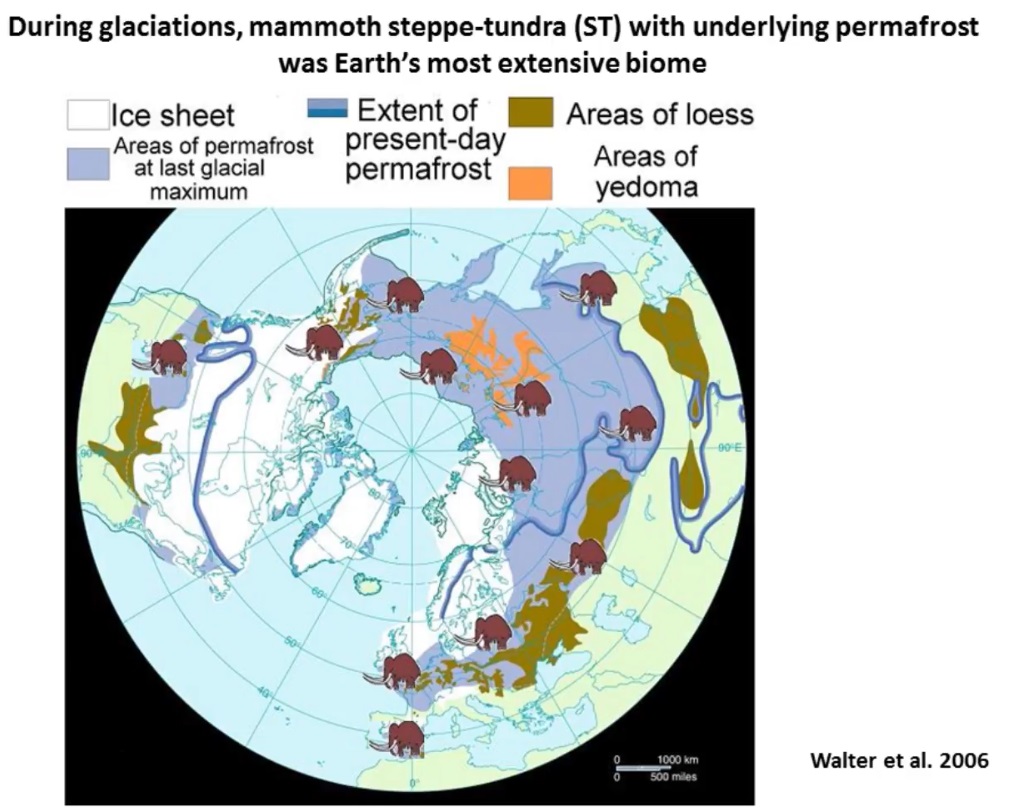
It occupied all the middle and high latitudes of the northern hemisphere. All that was not occupied by the glaciers was the pasture of mammoths, horses, bisons.
Mammoths lived in southern Spain, on the islands of Novaya Zemlya, in China, Alaska, and California.
Today we see the polar desert, tundra, taiga, broad-leaved forests, steppes, subtropics. And before, there was the same ecosystem. In all these climatic zones there was the same nature.
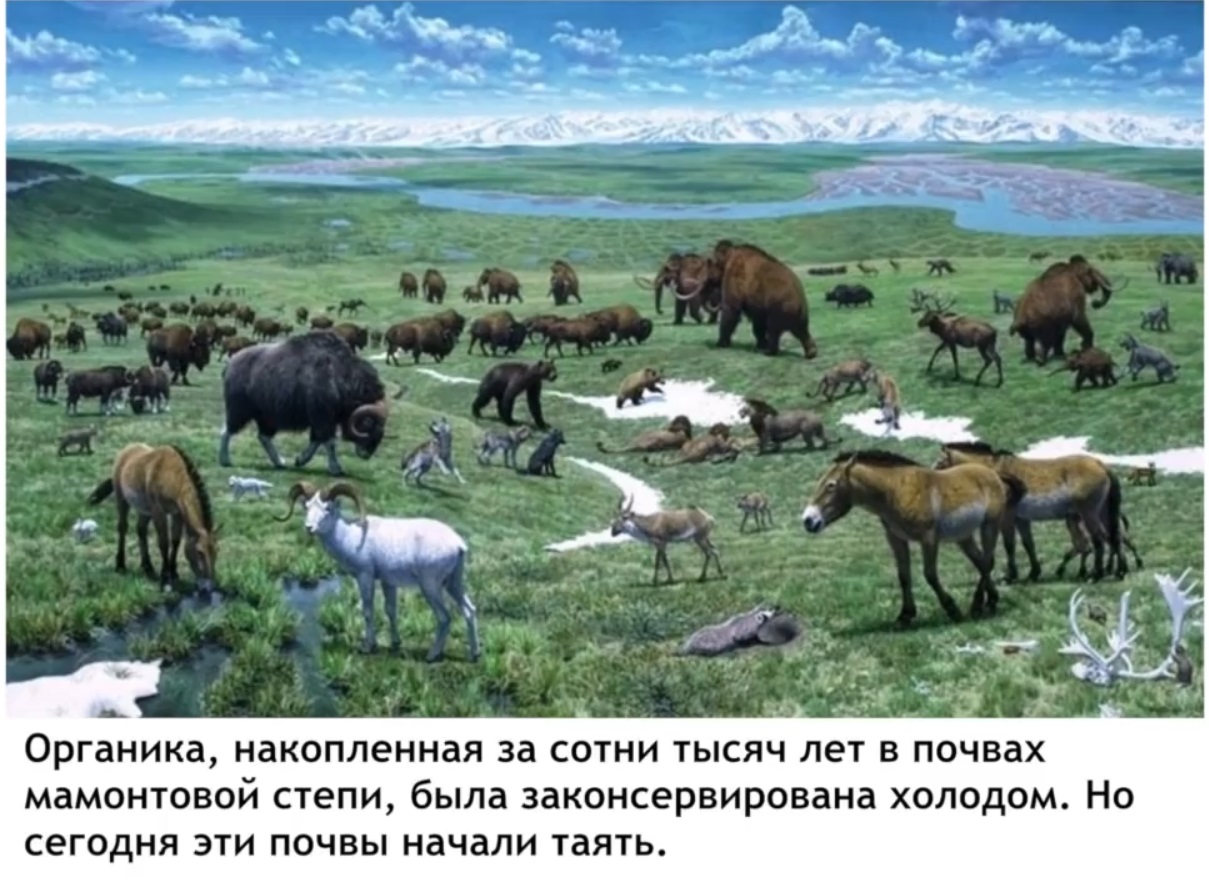
It was a highly productive system. And during its existence, it has accumulated hundreds of billions tons of labile organic matter in permafrost.
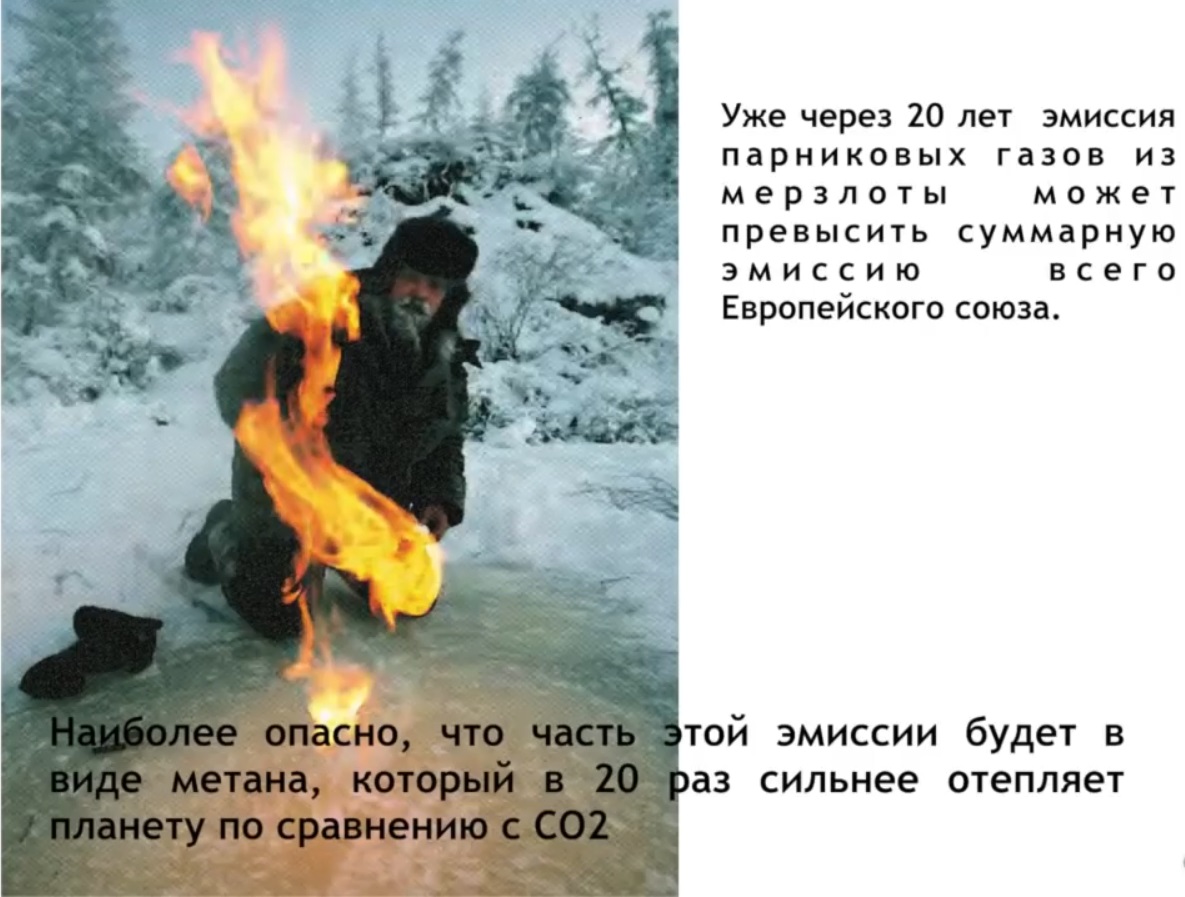
Now the permafrost has begun to melt, and soon the permafrost of Siberia and Alaska may become the main source of greenhouse gases in the atmosphere. This process may be irreversible. The permafrost has accumulated carbon for hundreds of thousands of years, and carbon has been released for tens and hundreds of years and cannot be returned to permafrost. Organics lies at a depth of 5-10-50 meters, and the soil accumulates carbon only in the upper layer of half a meter-meter.

10-20 years ago there were disputes about how this ecosystem looked. Someone was sure that it was like a polar desert with an organic supply of about 100 grams per square meter. It is not clear how mammoths fed in this ecosystem. But most artists have seen this ecosystem rich.
Why do we know about all these animals?

Their bones, and sometimes entire corpses, are in good condition. Every year they are found more and more often. In permafrost, these bones are not so easy to meet. But where today rivers, seas, lakes wash the shores, you can collect large collections of bones.
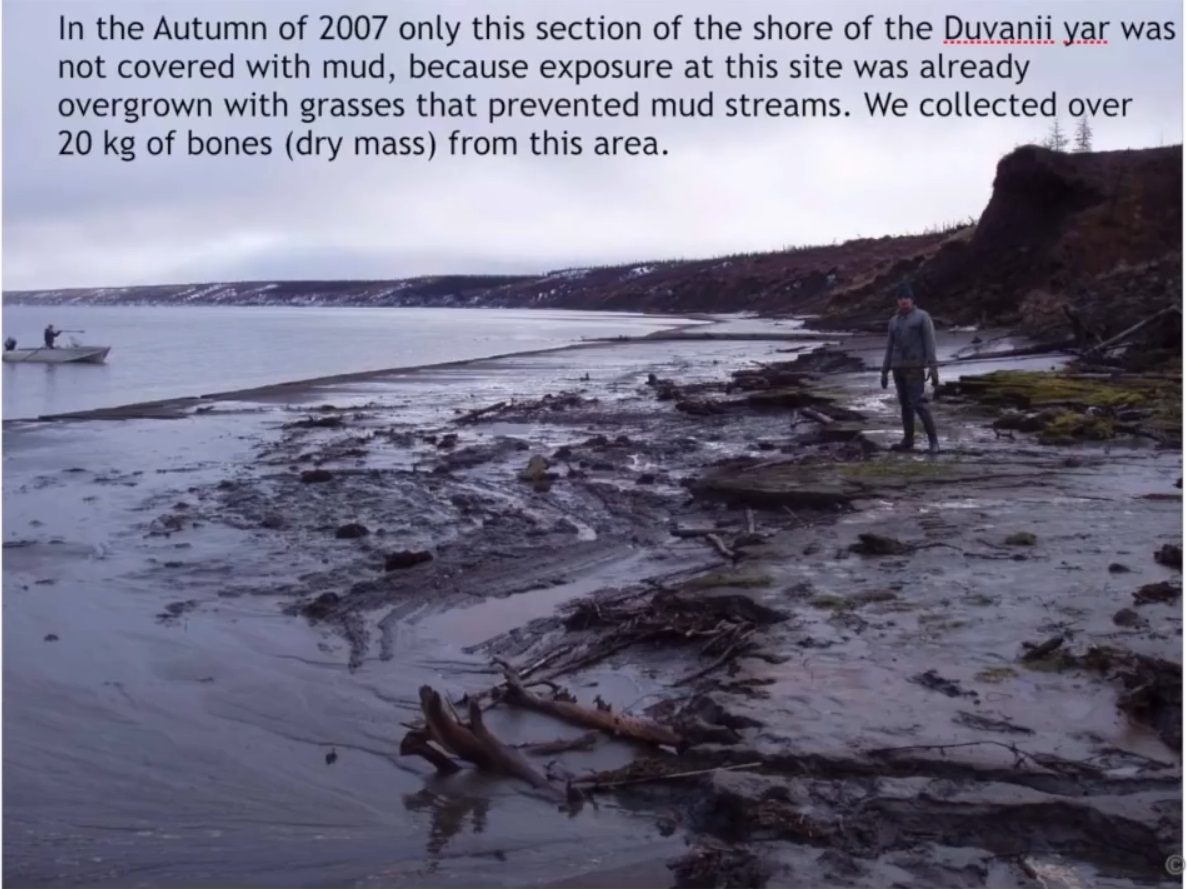
Duvanny Yar. The main bone preparations we carried out here. Every year the river is washed by several meters of permafrost and all the bones that were in the "wall" slide down, the current blows silt and all the bones remain on the beach.
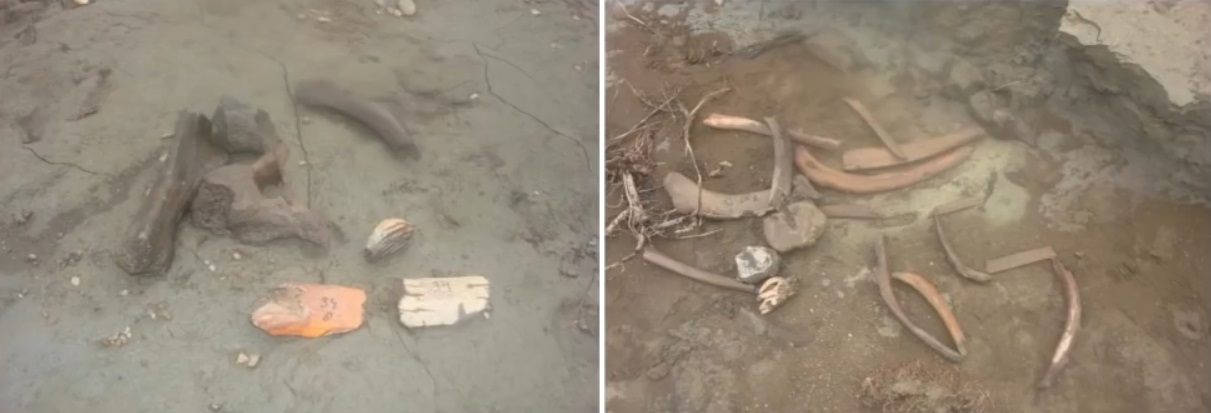
"Standard set" that remains from one mammoth.
You go along the beach and it is easy to determine where the mammoth died. From it remains 5-10 bones, tooth fragments, tusks fragments, several vertebrae.
From the bison there are less, 2-3 bones.
There is such an effect of “frost heaving” - all the stones and bones are frozen to the surface, where everything is quickly destroyed.
Every 30-40 meters along the coast lies the skeleton of a mammoth. Bones are easy to count and restore the number of mammoths. The bones of other animals are worse preserved.
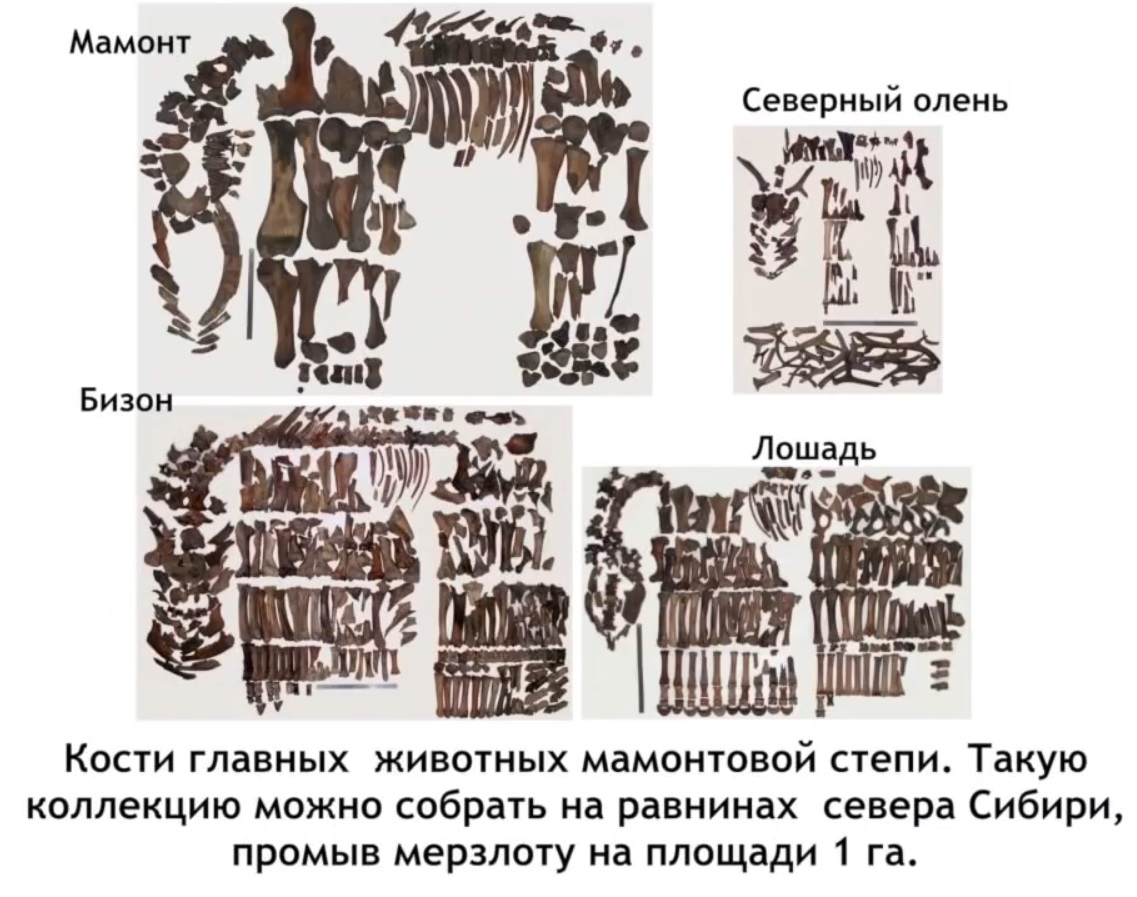
Here is a standard collection collected from an area of 1 hectare. There are only three vertebrae of a deer, but how many horns. The horns are tasteless, no one eats them, they are preserved well. And the vertebrae of a deer, wolves and wolverines, are cracked and swallowed in one or two bites.
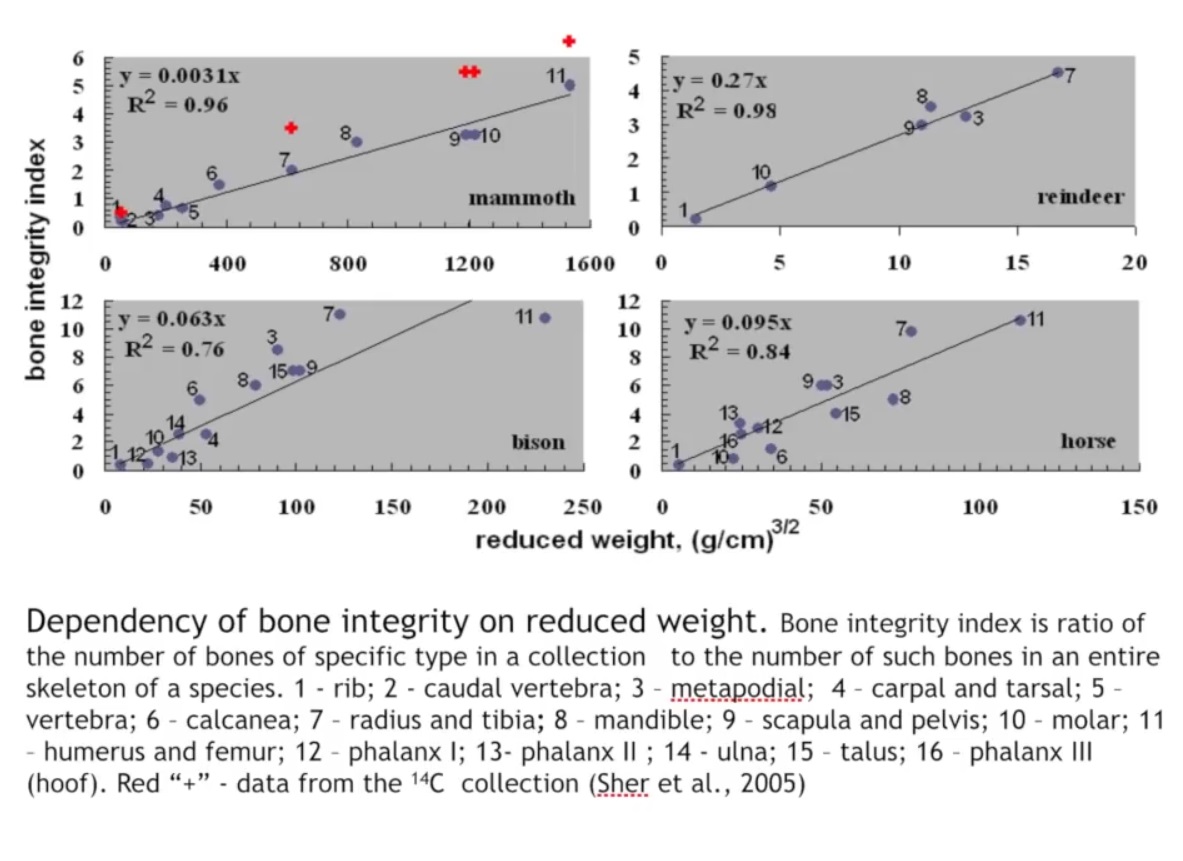
Thanks to the large collections, good dependencies were found. The weight of the bone divided by its length is 3/2. Good correlations. Blue - our points, red - Institute of Geology. Using such collections in various territories, it was possible to restore the density of dead animals in this territory during the Late Pleistocene.
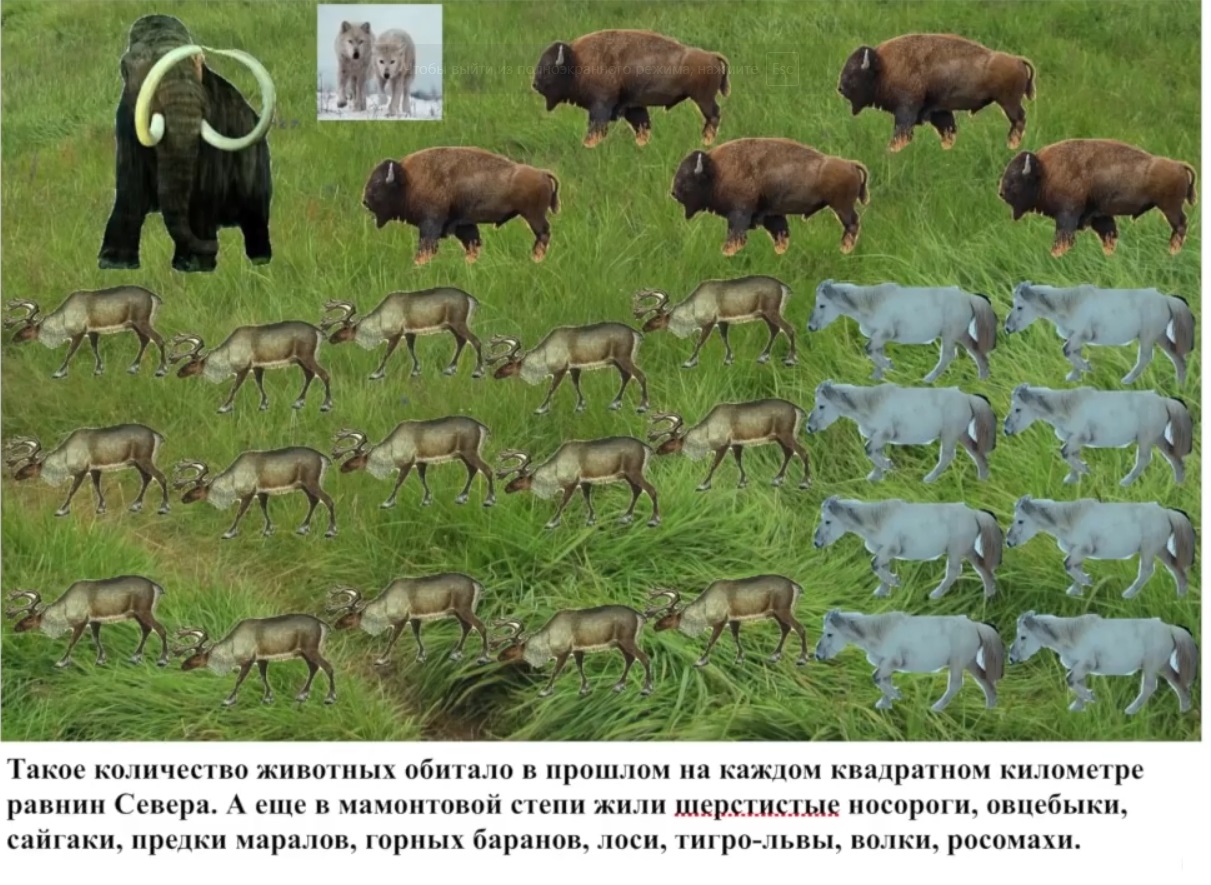
So many animals lived on every square kilometer. Plus one tiger / lion per 4 square kilometers. Not every African national park has such a density. And this is the extreme-extreme north and the height of glaciation. In places where the polar deserts are now, everything is littered with bones.
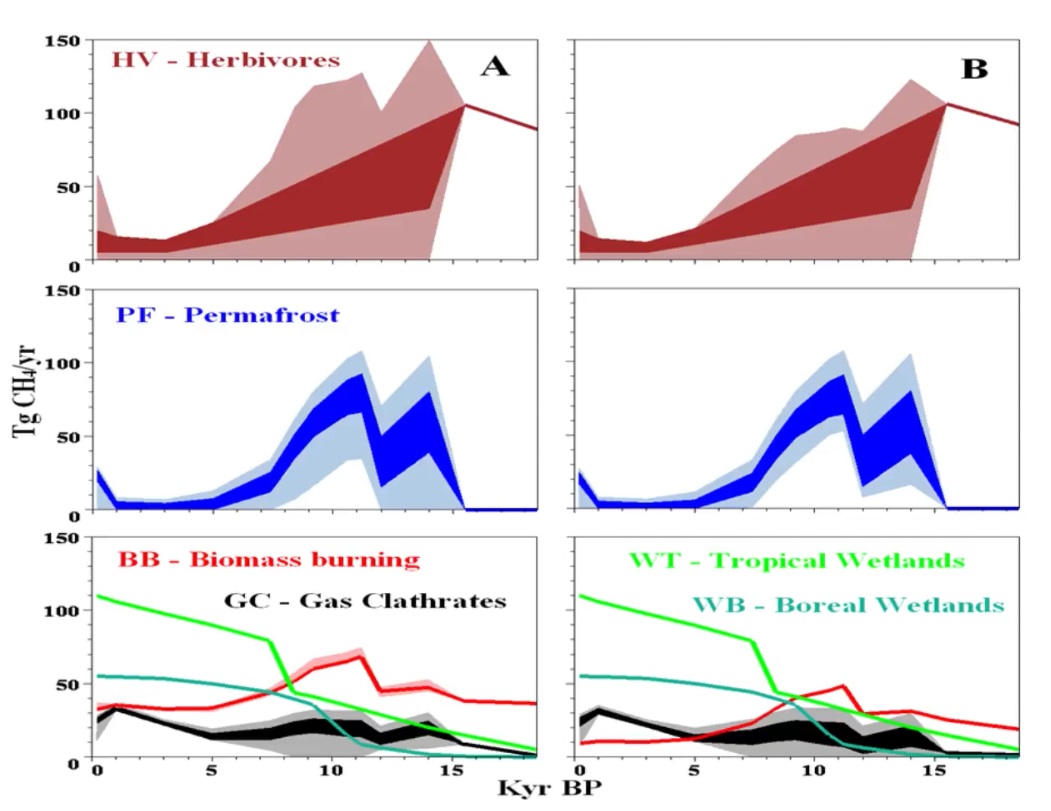
Calculation of methane sources. In the late Pleistocene, the main source of methane was herbivores. Knowing the total emission and separately taken animal, their number can be restored. The biomass of large herbivores reached two billion tons. Given the heart weight of 100-200-300 kg, we get 10 billion animals, which equals the bio-productivity of the terrestrial ecosystems of our planet.
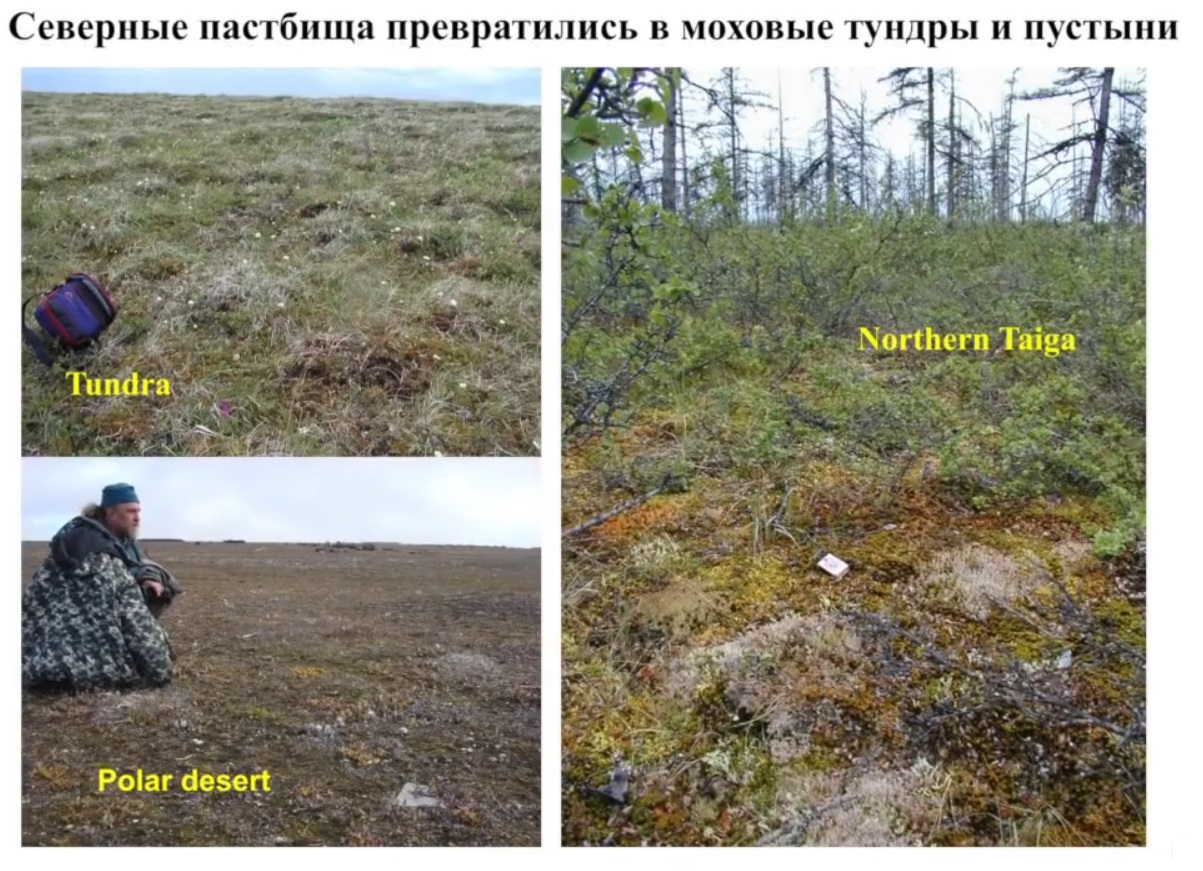
And this is what the northern ecosystems look like today. Do not feed anyone. And in the past there were ecosystems not inferior to the African savannah. How can this be?
A bit of Wrangel Island atmosphere:


Nails against arrogant bears.

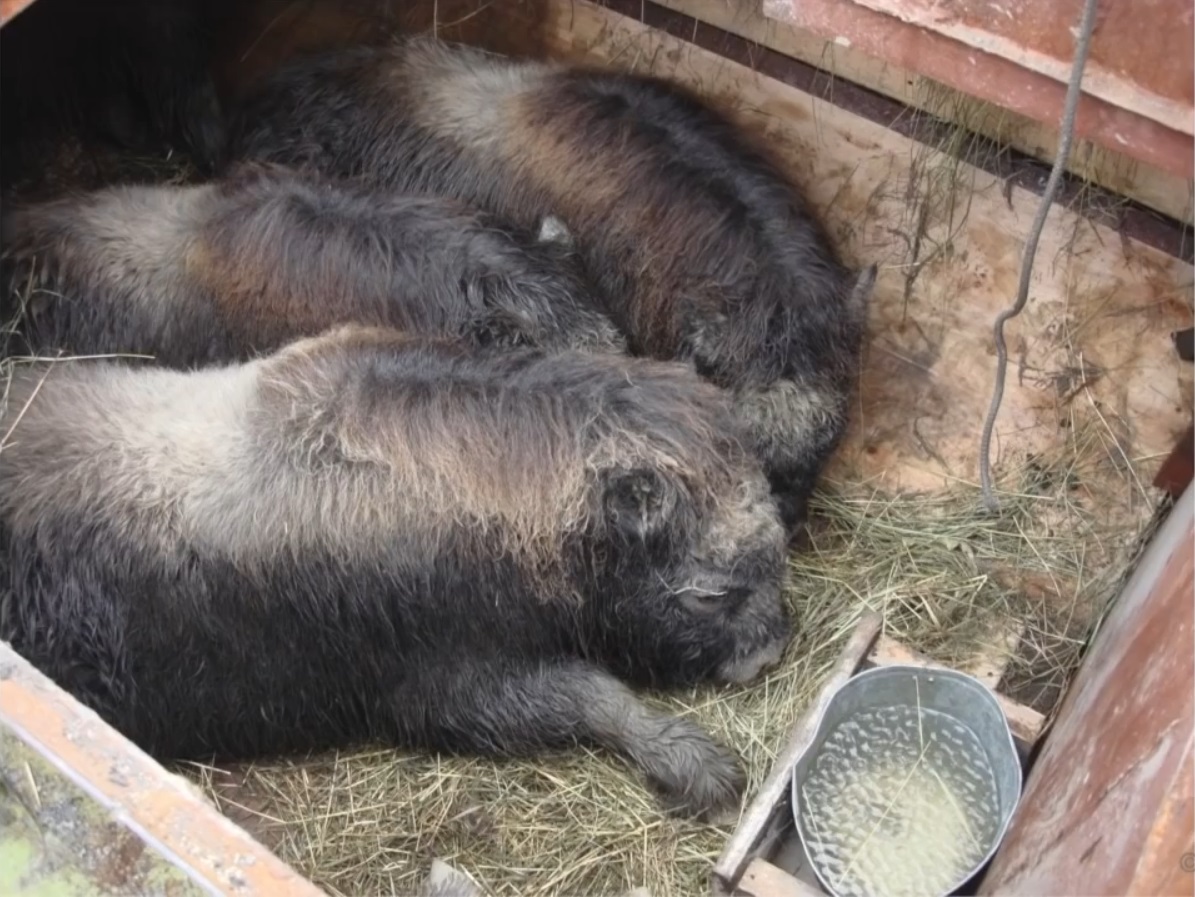
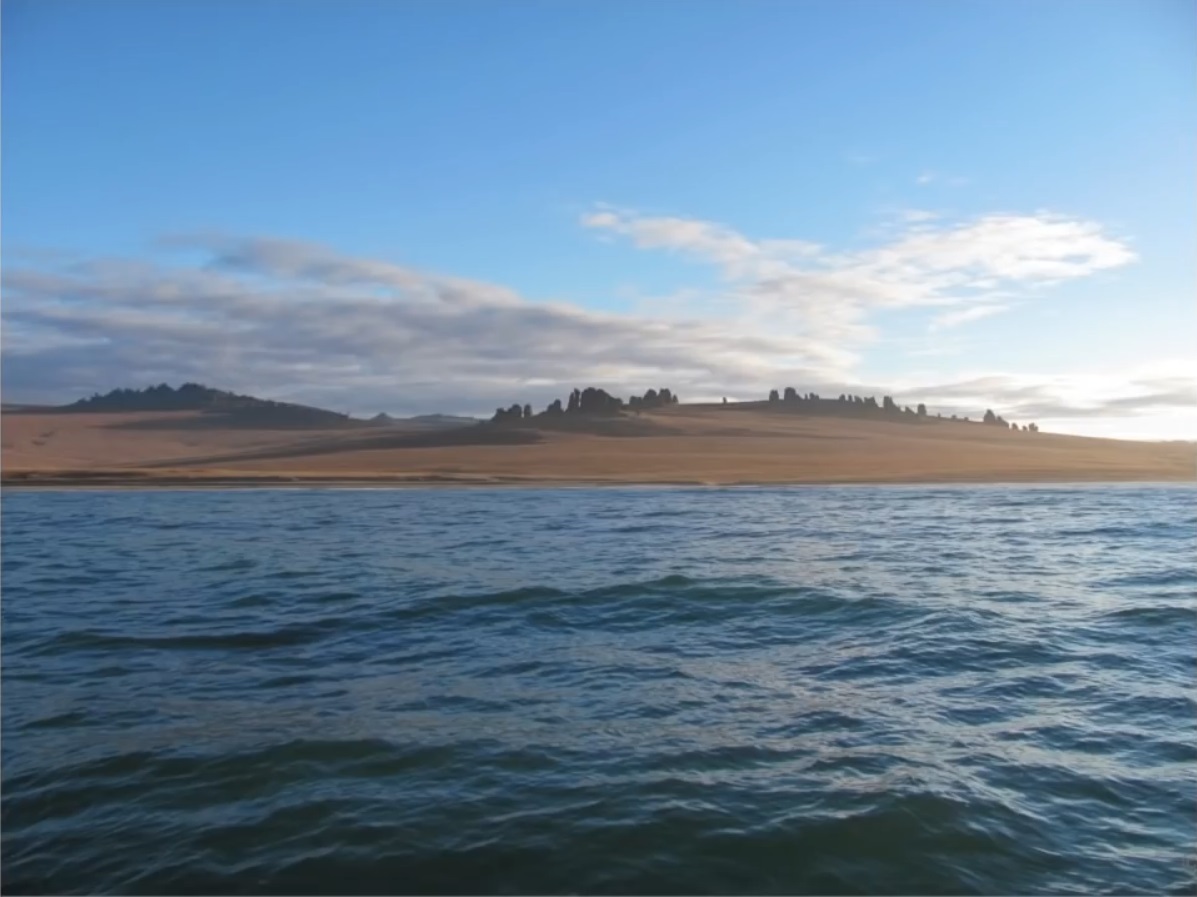
Extremely harsh place.
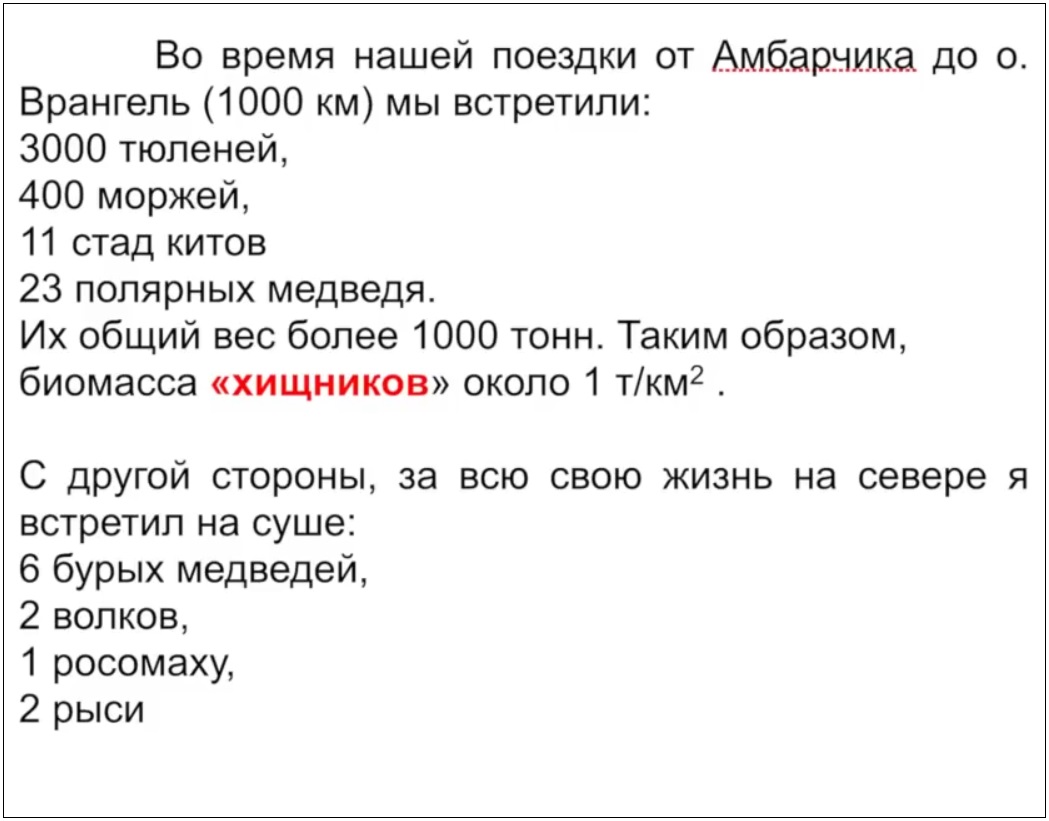
But we sailed through the soup. Seals are everywhere. Fountains of whales. Bears on every ice floe. The harshest place in the world, and look what kind of biomass there is. And on land - the biological desert. During the week in the Arctic, I met a thousand times more animals than in my life.
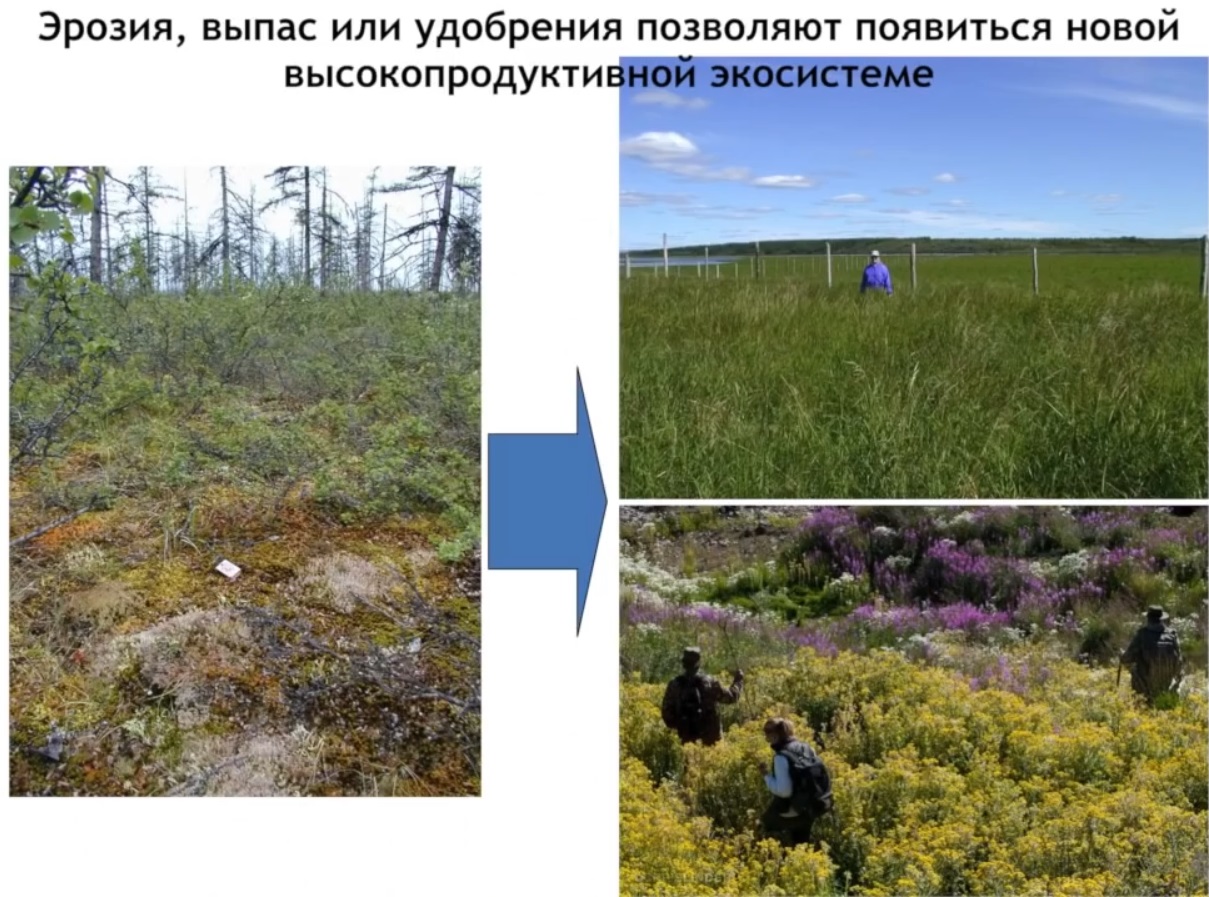

+4 temperature in July, and the grass spikes like rice.

Grass in the north grows everywhere. The tractor drove - overgrown with grass. The reindeer herders stood for one night - the next year it was overgrown with grass. The main thing is that someone trampled the moss - and the grass will grow.

There were so many mammoths on Wrangel that they broke into two species. A large one who worked as a mammoth and small mammoths appeared that occupied the niche of horses.
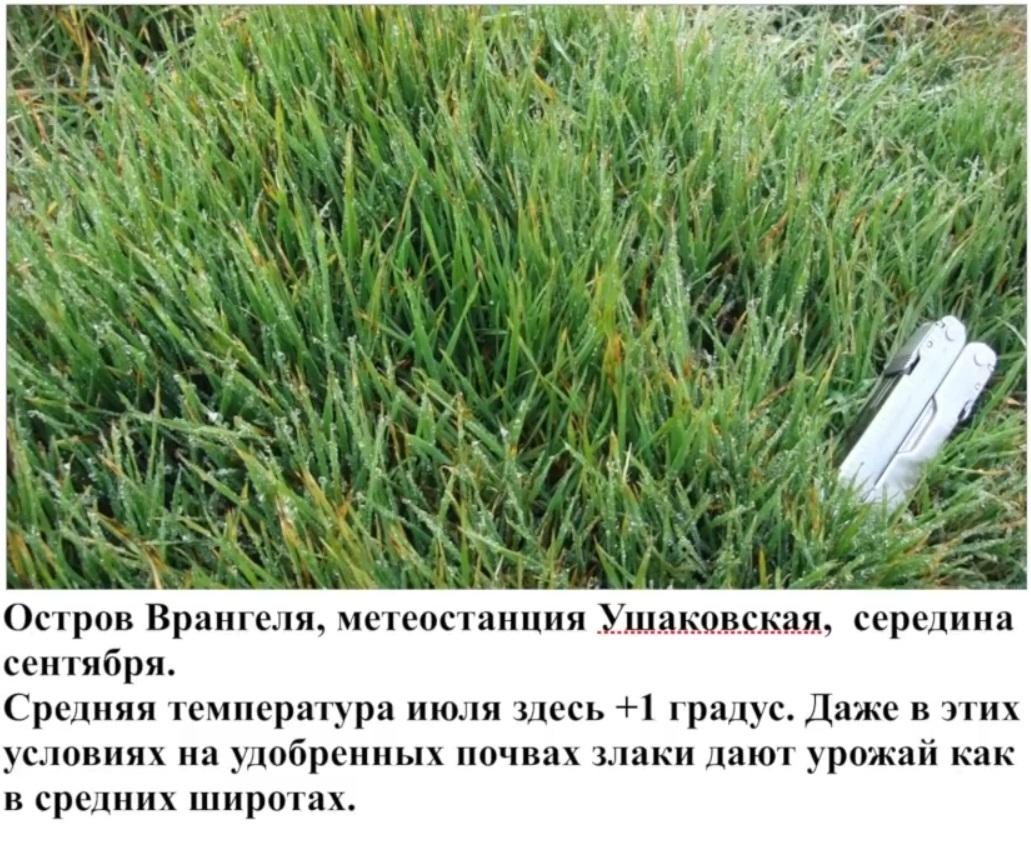
Mid September. By our standards, it is already a harsh winter, and the grass is growing. For photosynthesis, temperatures are not needed, if only there was a plus. This is a photochemical reaction. And the grass grows. They need fertilizers - nitrogen and phosphorus.
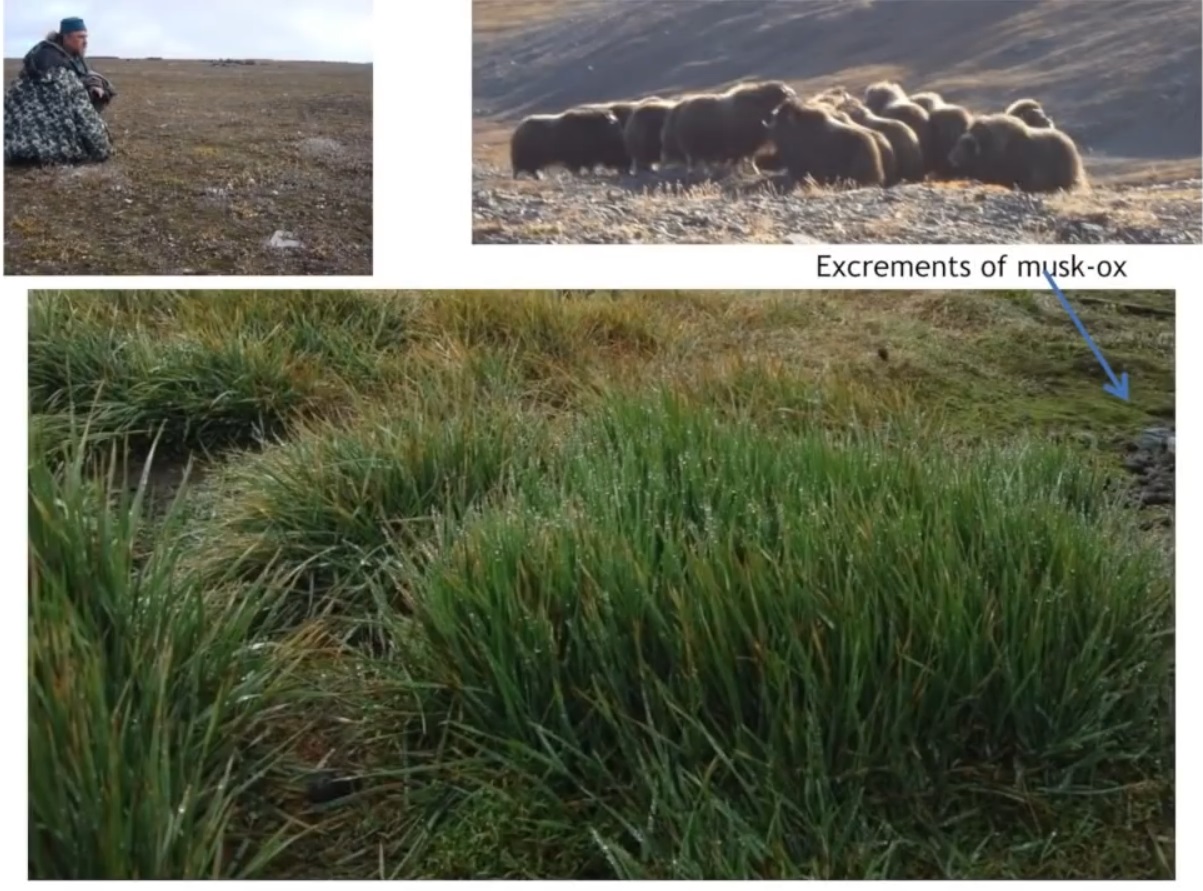
In this place, musk ox peeed and poked.

30s were years of warming in the Arctic. Gorodokov was mistaken 30-50 times.
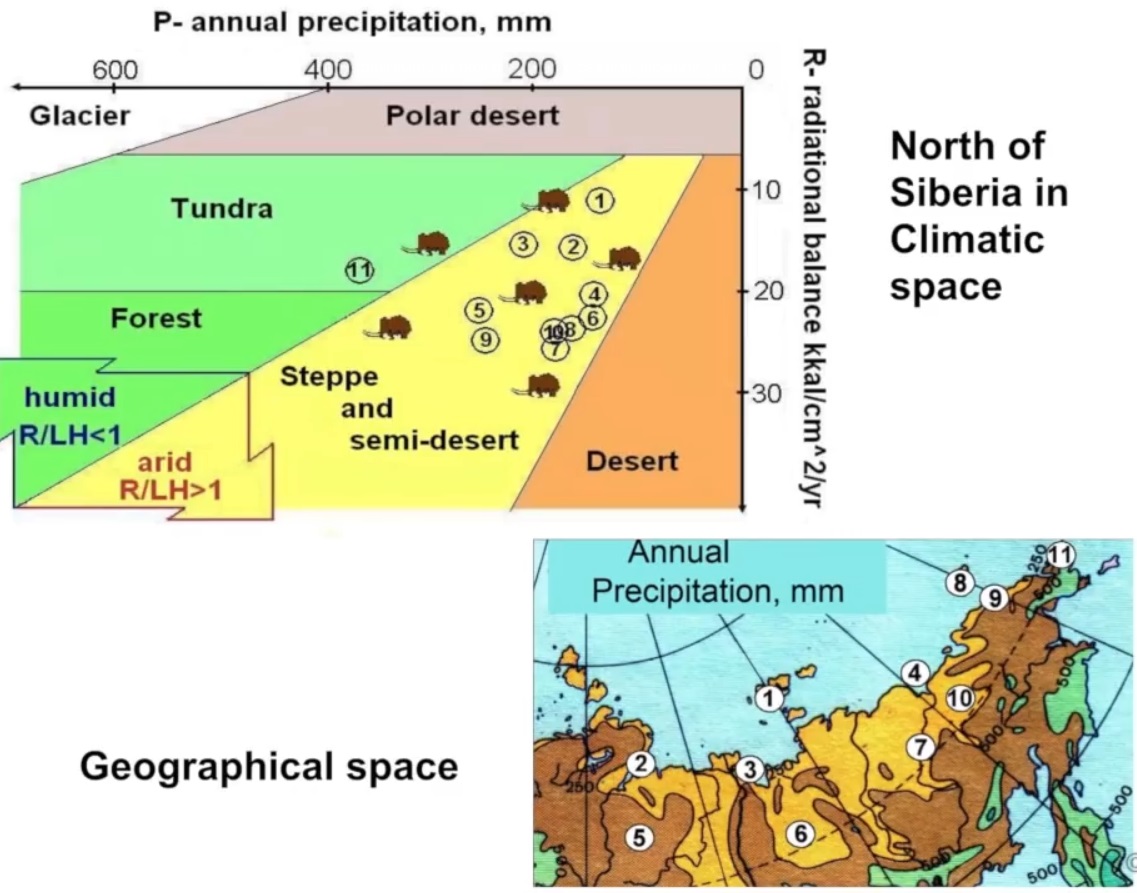
Beasts just appeared, the biocircle became more active, manure appeared, grass grew, more feed.
When discussing the question “Why were there so many animals before?” The main hypothesis was that there was a “special” climate in the north.
But look at the climate field. On one axis, the amount of precipitation, on the other axis - the radiation balance (how much the sun shines).
In the center - a line showing that there is so much heat to evaporate all the precipitation. All that is higher is an excessively humid climate, lower is dry.
All weather stations in Eastern Siberia, where radiation balance is monitored. Today’s climate of East Siberia is a dry climate of the steppes.
Why do we see so many swamps? But because nothing is growing. In the wild, almost nothing evaporates from the surface of the earth. Evaporates from the surface of plants. In poor soils, mosses and lichens grow, without roots. They cannot dry the soil.
Today's climate is great for pasture ecosystems. But why did the steppe die?
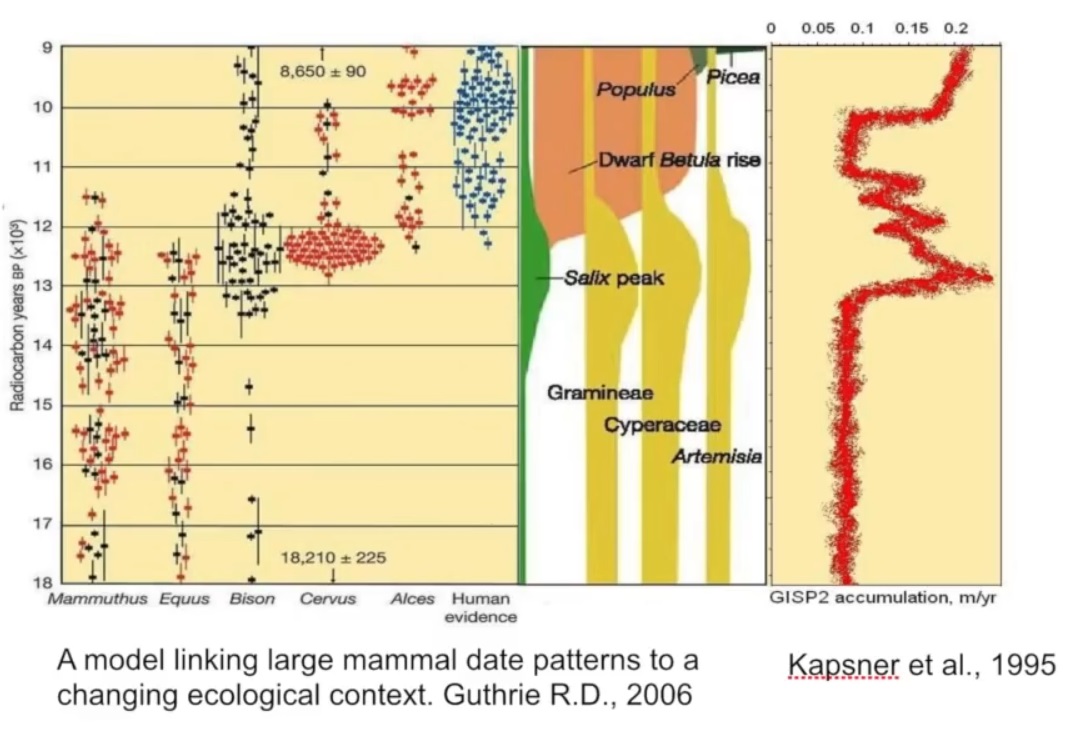
How the climate has changed from -18,000 to -9,000 years. Transition - Holocene. 13 000 years ago there was a sharp jump in climate. The amount of snow in 1 year increased from 6 to 25 cm of snow. There was a sharp humidification of the climate. There was a warming and more feed. The biomass of animals has changed. mammoths have not changed, horses (equus) have not changed, the number of bison has sharply increased. Dramatically increased the number of deer (cervus).
Then the climate began to return to its original state. But a birch (betula) began to grow, which no one eats. There has been a radical change in pastures to shrub-forest communities. Why?
The first person appeared in Alaska ...
All horses immediately disappeared. Mammoths quickly disappeared. The number of bison and deer sharply decreased. Pastures degenerated and flooded the forests. The climate did not play a role, except for the one that became warmer, and it became easier for a man with his snotty children to survive in the north. Warming provoked the expansion of people to the north and after that the natural ecosystem collapsed.
A man did not have to exterminate everyone under the root, it was enough to reduce the number - and they would no longer be able to maintain their pastures. The pastures are hushed, overgrown with shrubs.
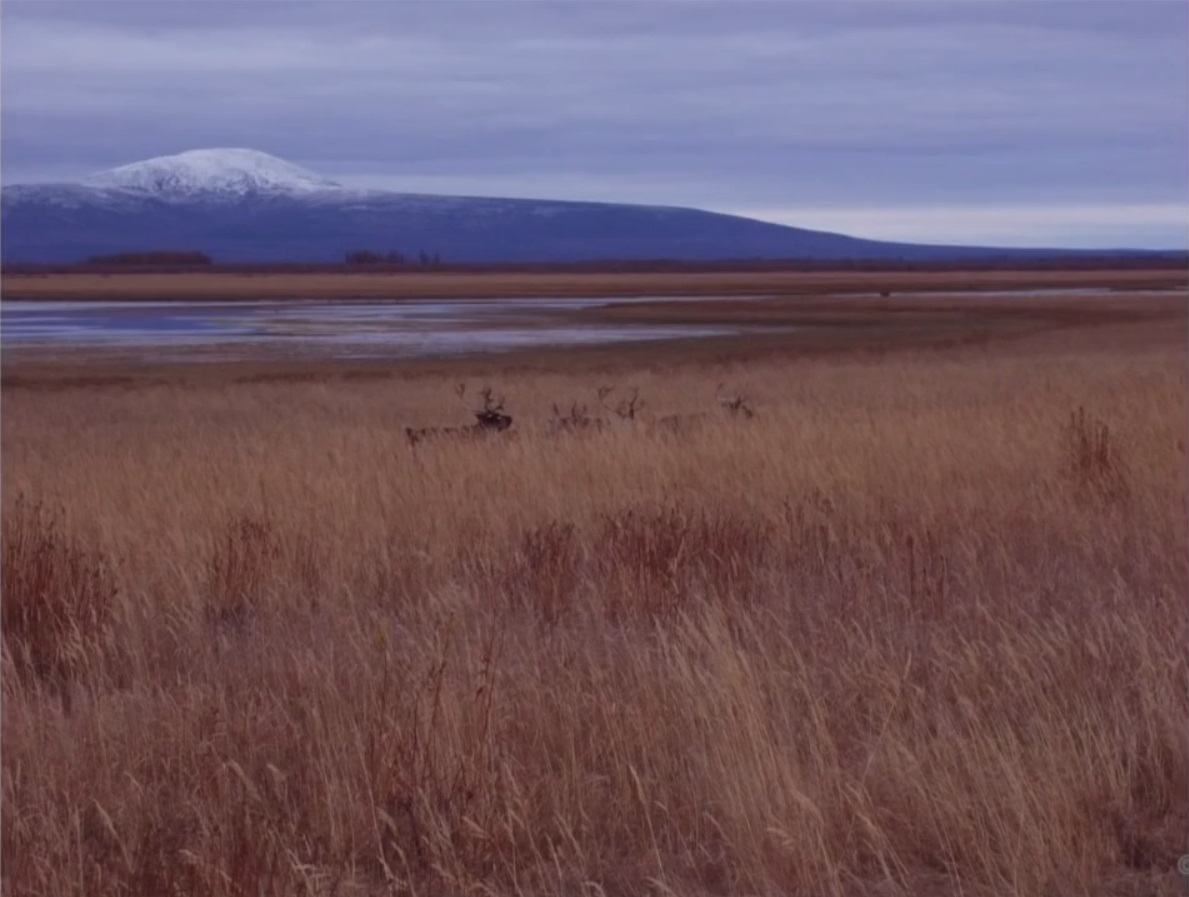
Today in the north is full of ready-made pastures. Reindeer is not visible, such a tall grass. "Brooms" 2 meters 30 cm. Grow at a speed of 14 cm per day. If only there was nitrogen in the soil. At least a little bit.
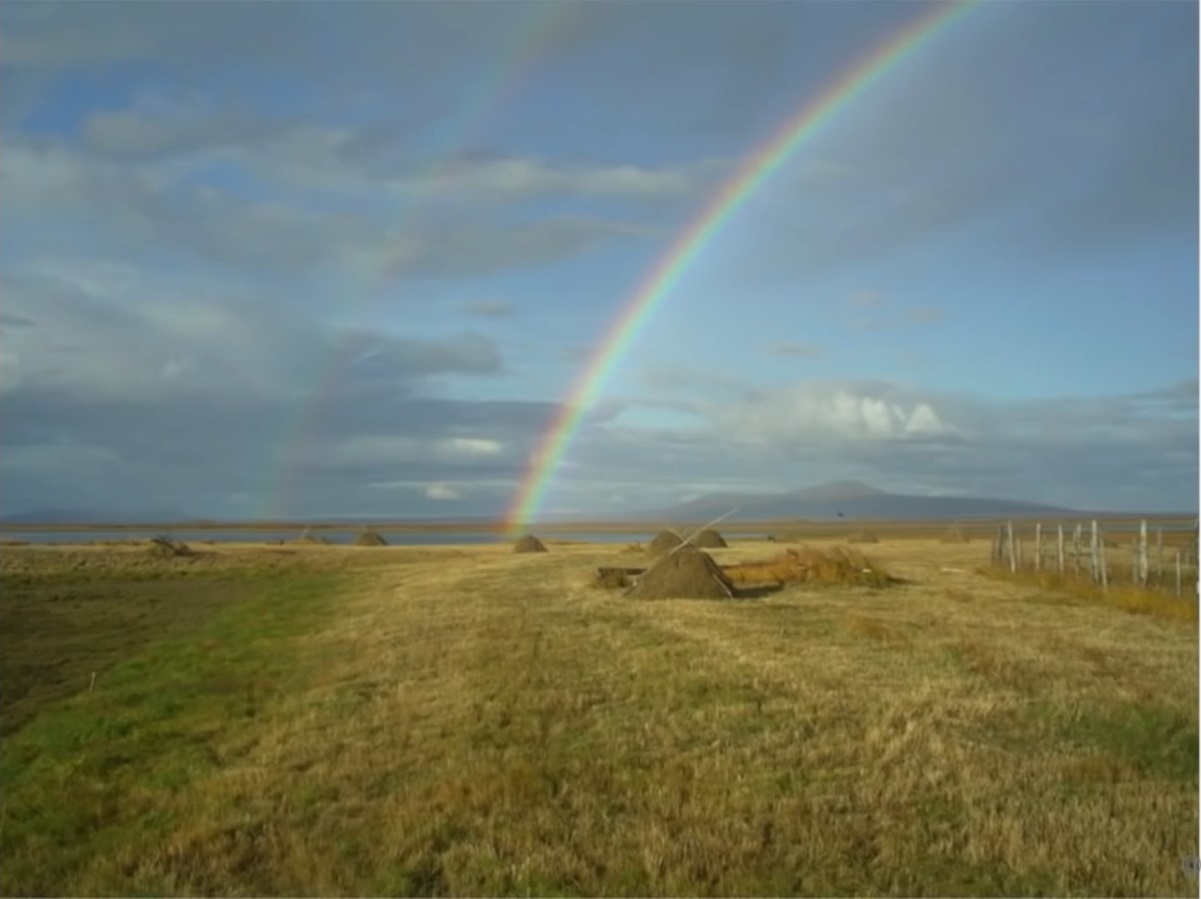
Hay can be mowed.
Millions of herbivores supported their pastures. Grasses without herbivores are unstable.
What is a biocircle? This is photosynthesis, and then decomposition. All nitrogen, potassium, phosphorus should return to the soil. If it doesn’t return, the new grass will not grow. Photosynthesis is not limited by temperature, and decomposition is limited. It is cold and dry on the ground. Until the grass rots, a new one will not grow. In the meantime, mosses and lichens will clog pastures. There are no problems with photosynthesis, but how to quickly decompose organics is a problem. Coldly. But in the warm stomachs of large animals, in any climate, in the midst of winter, any organic matter decomposes in a day. Large herbivores sharply activate decomposition and provide a high speed of the cycle.
While there were animals - there were rich ecosystems, there was a lot of grass that fed many millions of animals.
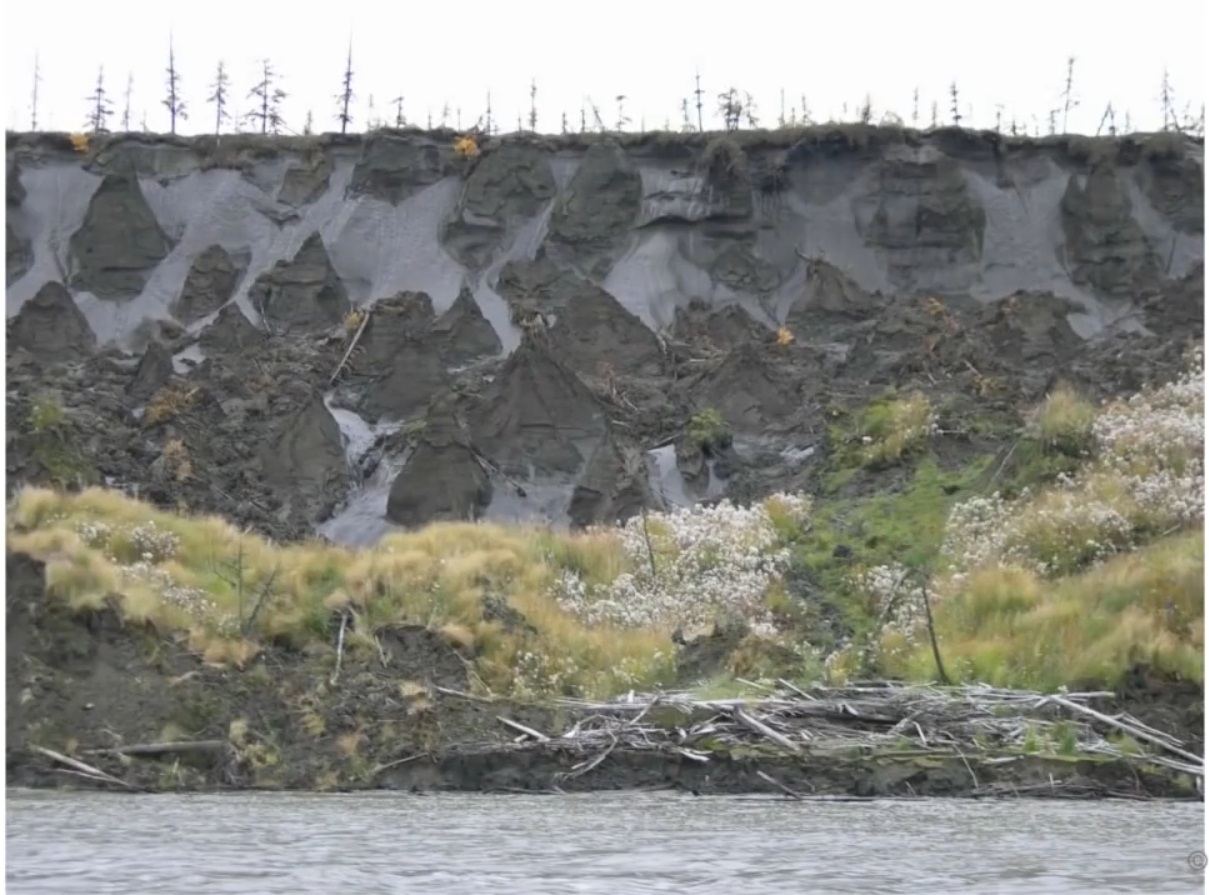
Mammoth soils are fertile. The dirt is creeping, and grass is already growing on it.

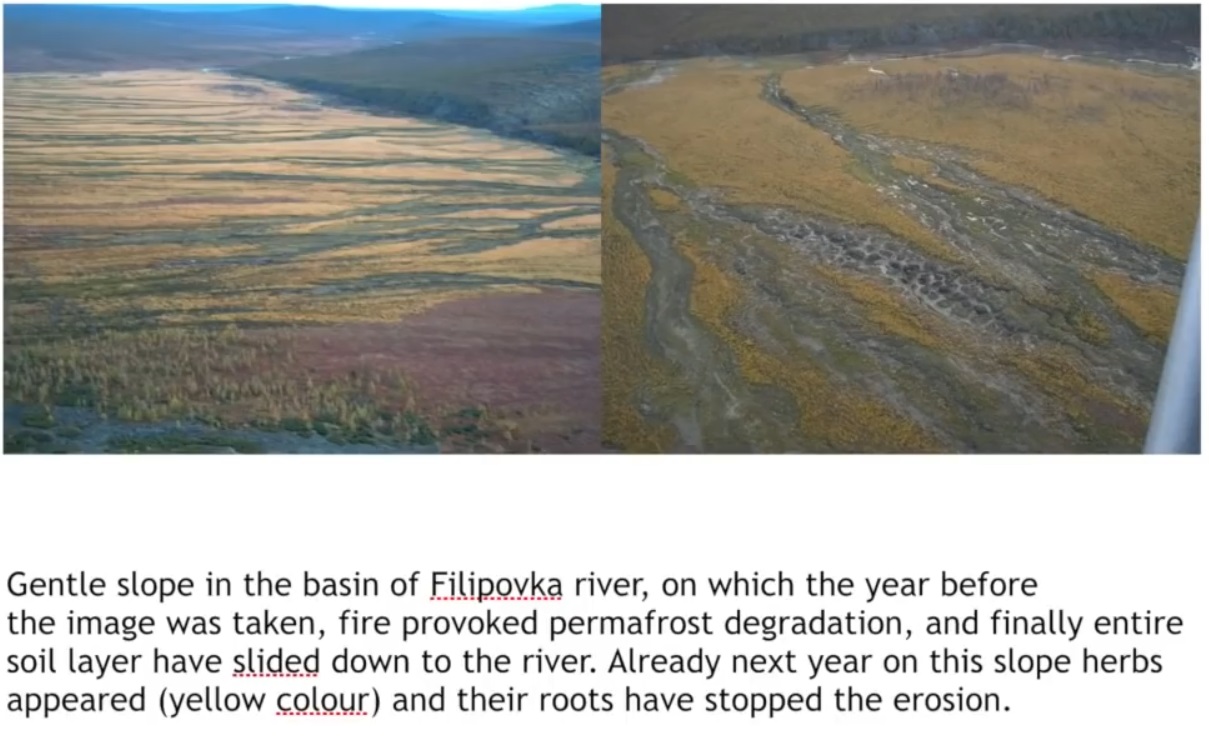
An example is the Filipovka River. A fire passed, the moss layer burned out, all the soil crawled into the river. By area less than 1%, but the whole river turned into a mud stream.
Imagine that in the Kolyma river basin 1% starts to melt? All Kolyma will turn into a mud stream. All the mud will flow into the ocean, and the white ice will cease to be white.

The permafrost thawed by 6 meters, and look at what vegetation is juicy, tasty.
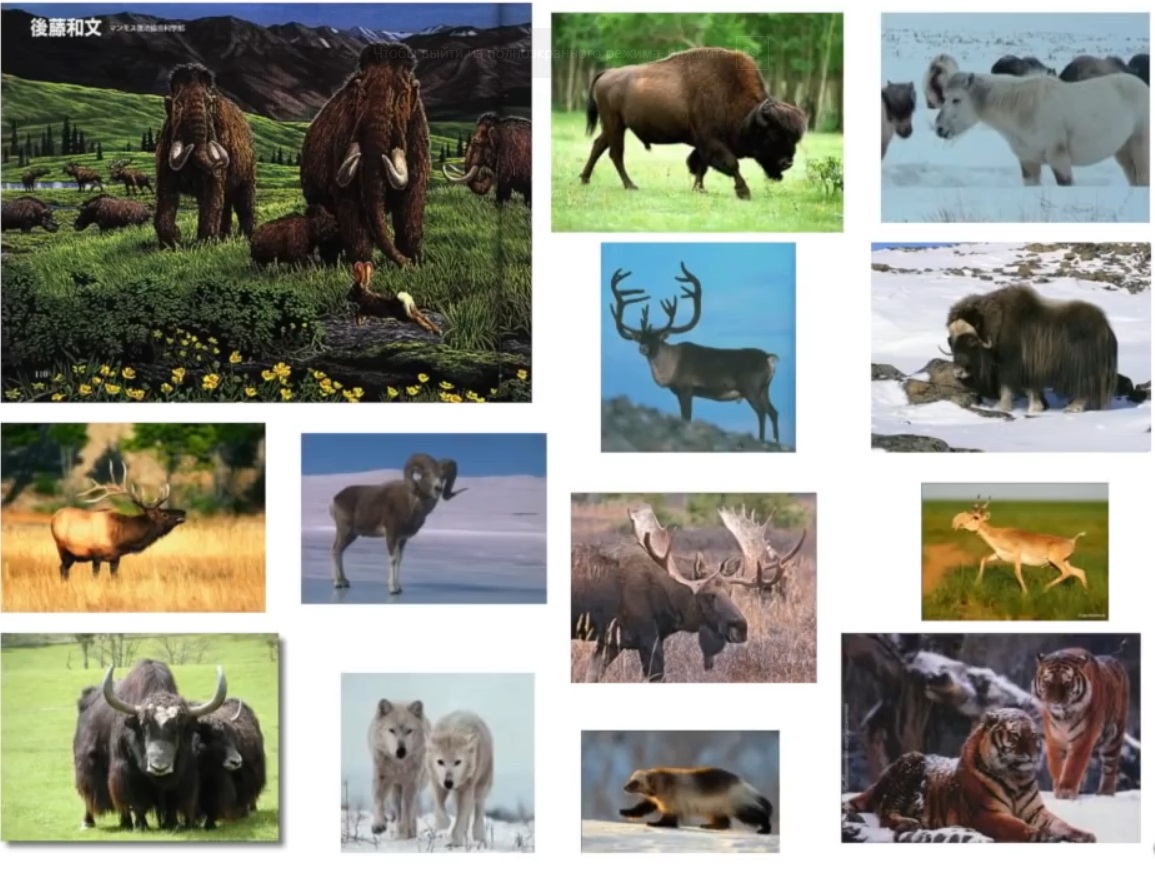
The climate today is the most suitable. There are plenty of pastures and every year there will be more. And almost all the animals survived. Lost only the mammoth and rhino.
A look into the future:
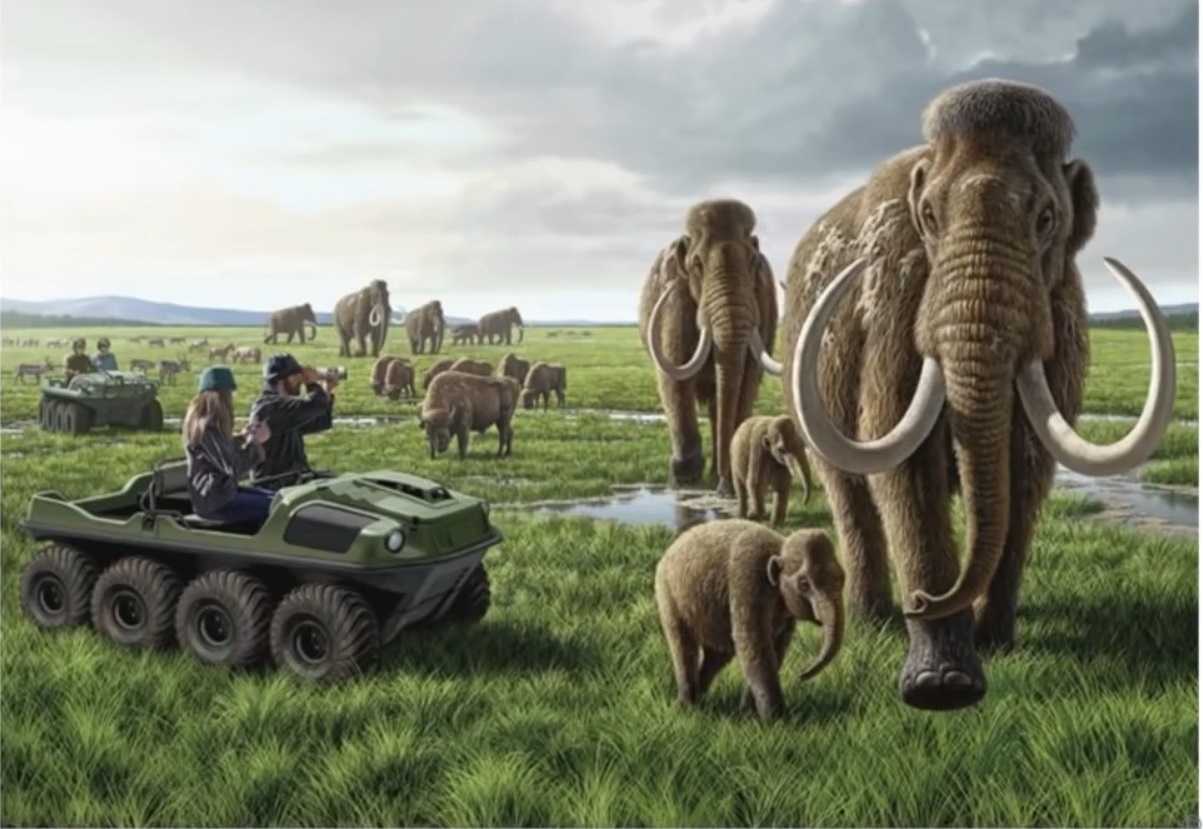
I have long explained to artists when someone sheds how grass should be trimmed.

And this is a photograph. We have in the north.

There was a forest, the trees are drying up and look what grass instead of moss. Then they pee three times and eight times poop, this was enough.
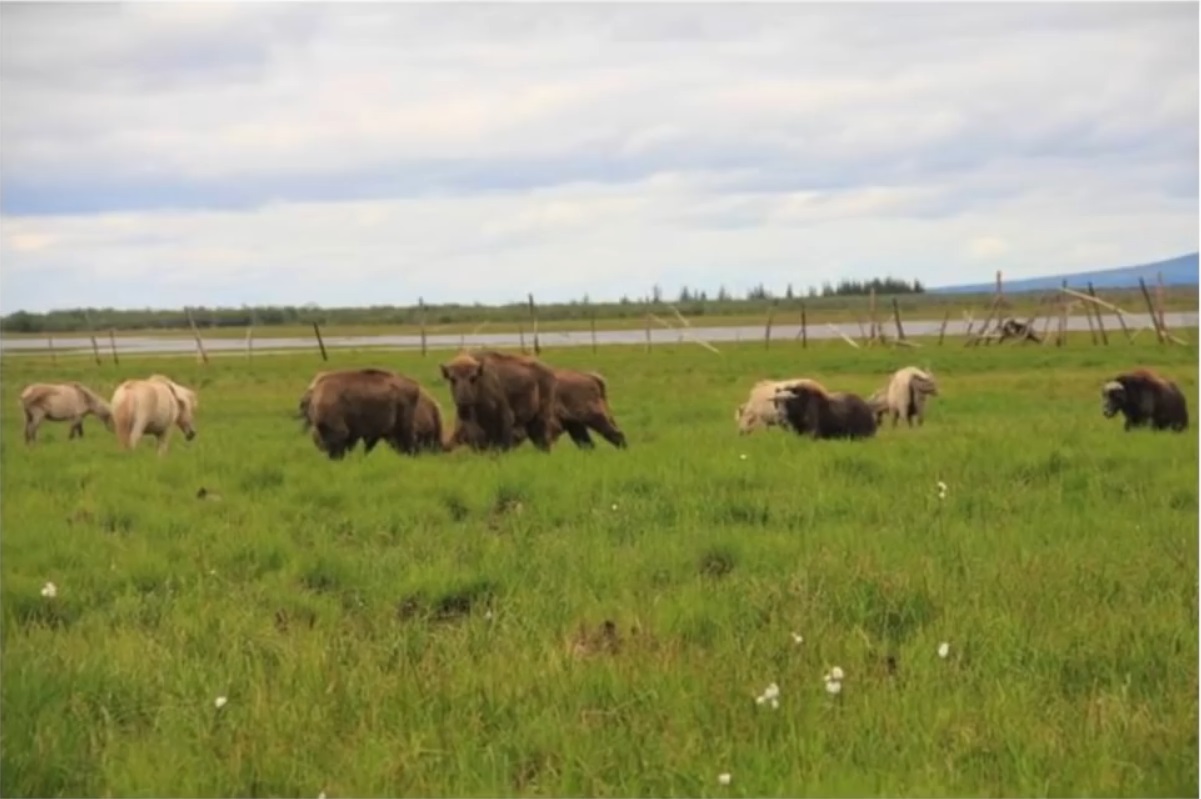
And then there was a swamp, but now everything is drier and drier. Oxygen penetrates the entire soil profile.

And it doesn't take a lot of money, you just have to do it.
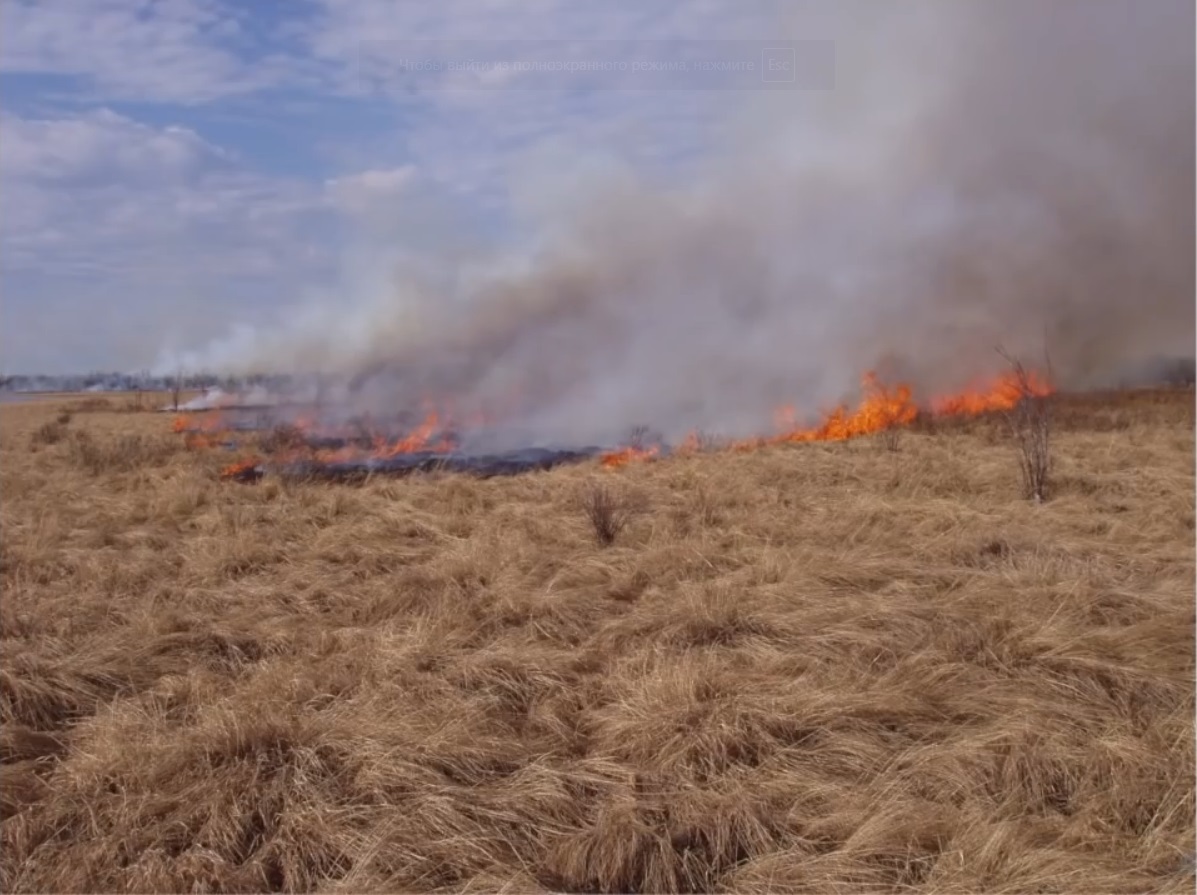
It used to be like this in the spring.
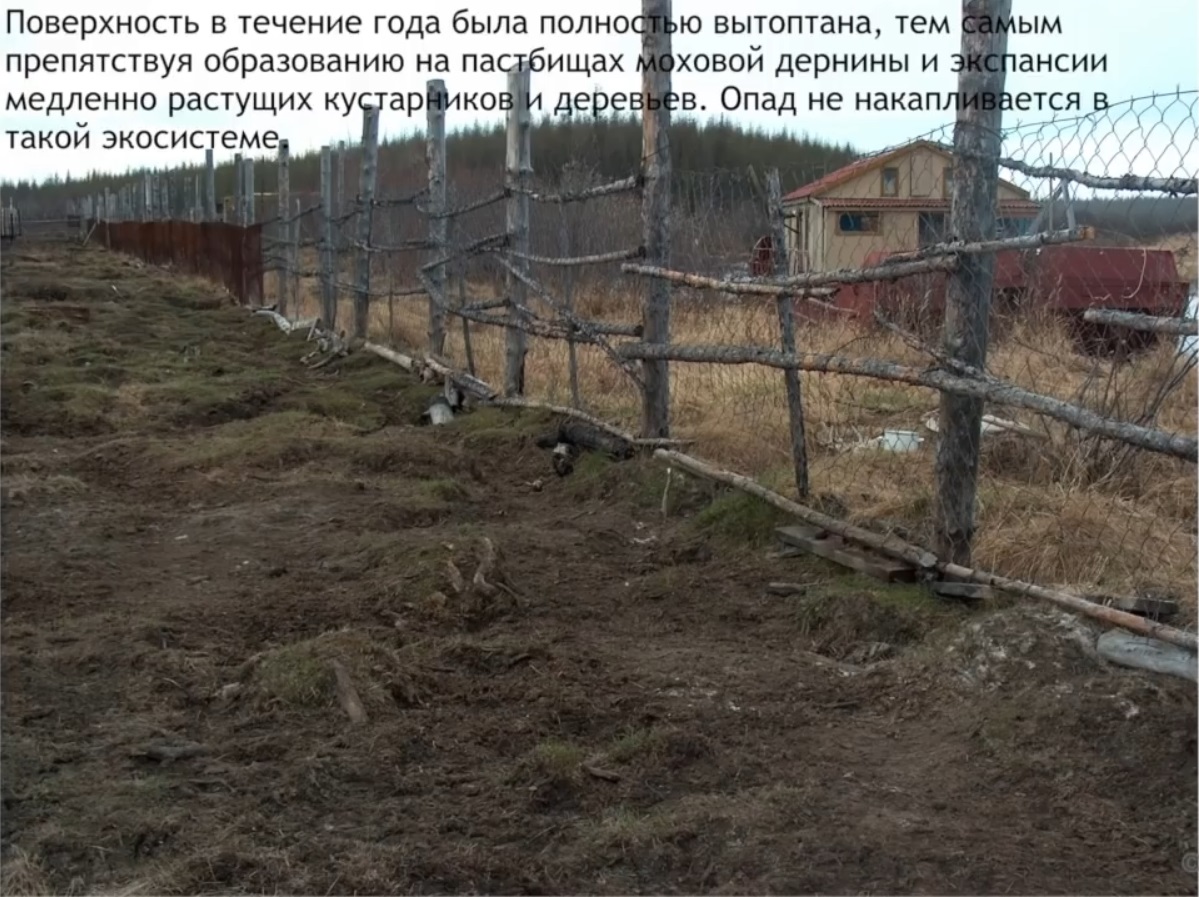
Today like that. Everything is eaten "at zero". Only heaps of manure. Everything that has grown over the summer, over the winter returns nutrients to the soil.
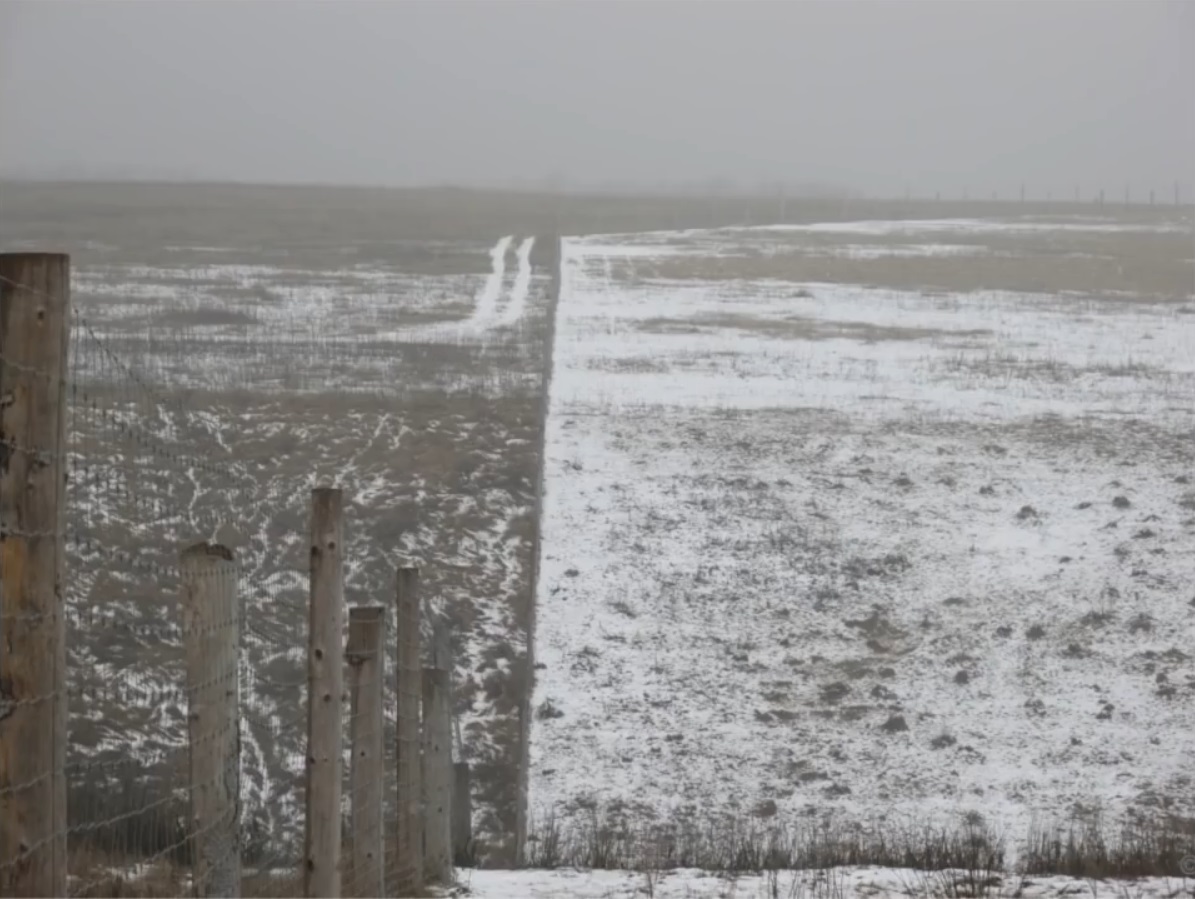
This ecosystem affects both the soil and the gas regime of the soil, the composition of vegetation, and climate.

Dark forest, bright pastures.

And in winter, black / white.
Today, “dark” dominates in the winter, and earlier - in the winter and summer there were light pastures.
The task is to preserve permafrost. And the permafrost temperature depends not only on average annual air temperatures, but also on snow. On the street -40 and -10 under snow. In winter, the soil does not freeze.
Under untouched snow, -10, and on pastures where animals loosen snow, -30. During the winter, the soils are so cooled that the permafrost temperature on average decreases by 4 degrees.
Just let the animals go and you have 4 degrees in reserve.
If the permafrost suddenly begins to melt, it will immediately overgrow with grass. You just need to have a bunch of animals ready to drive them there. Technically simple.
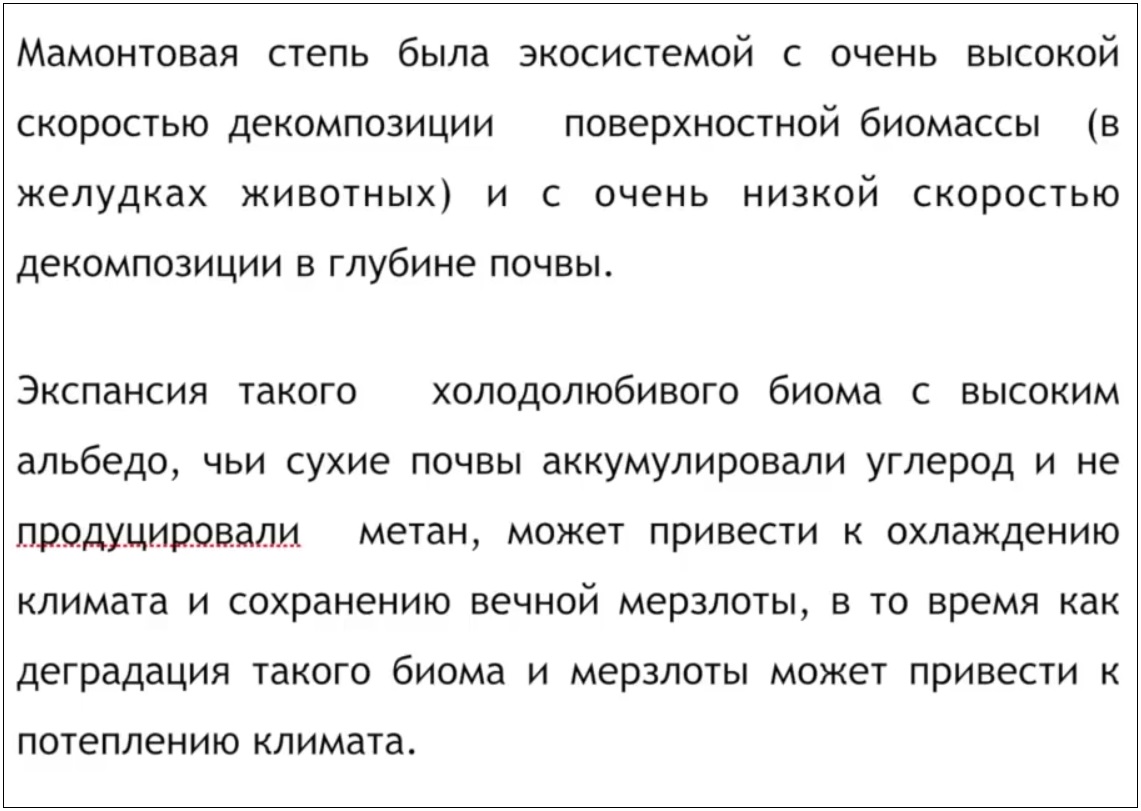

Wild Field Manifesto (PDF)
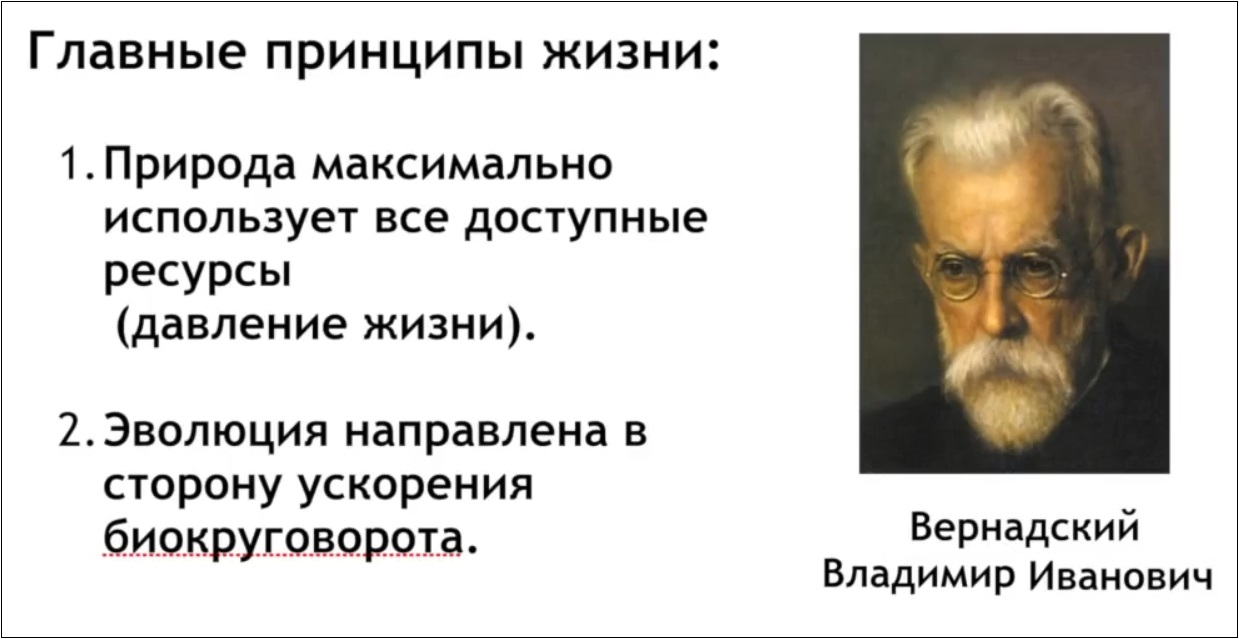
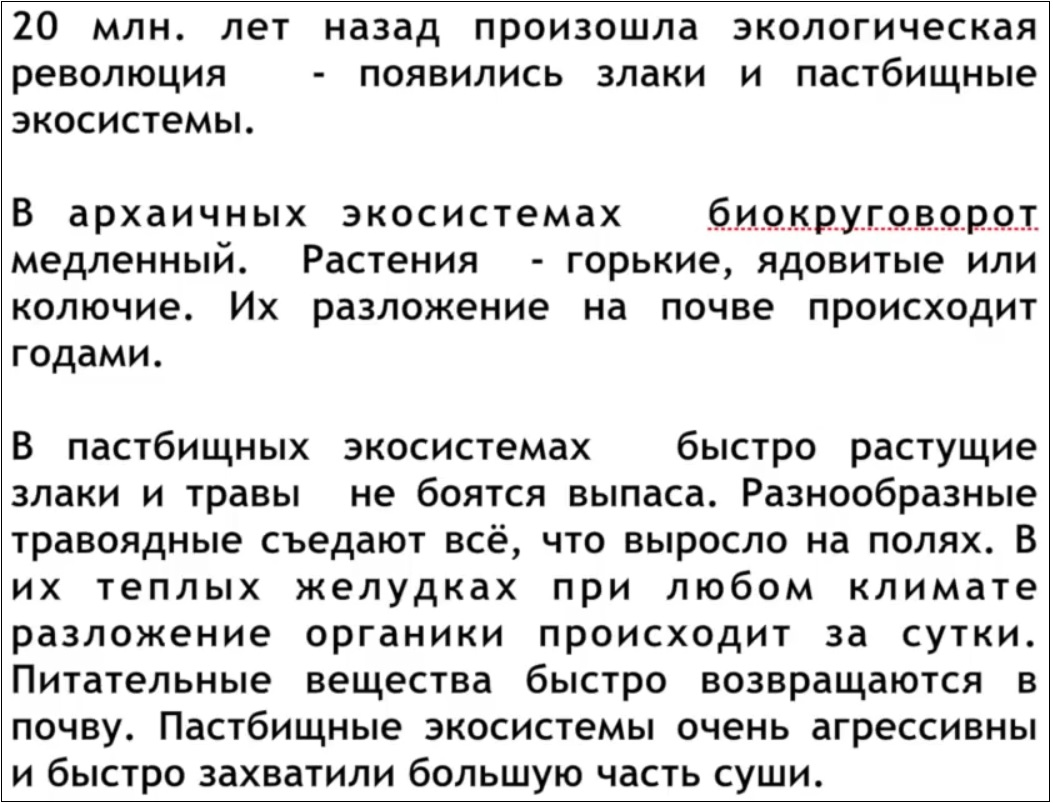
There was a long arms race between plants and animals. As a result, they have a huge liver to digest all protective poisons - nicotine, caffeine, strychnine, morphine. 20 million years ago, cereals appeared that did not spend time on defense, they freed up a bunch of resources that they spent on rapid growth. Some herbs grow 1 meter per day. A new survival strategy has appeared: I am ready to feed many horses myself, but I need a lot of nitrogen and phosphorus. There was a symbiosis between animals and plants. Plants feed animals, animals return fertilizers and at the same time trample / eat out "competitors".
Spruce needles live 10 years, bitter, no one eats. They fall to the ground, where their mushrooms are laid out for about 20 years. The turnaround time is decades. In the pasture - weeks. The speed of the biocircle increased by 100-1000 times. Super-aggressive ecosystems have appeared.
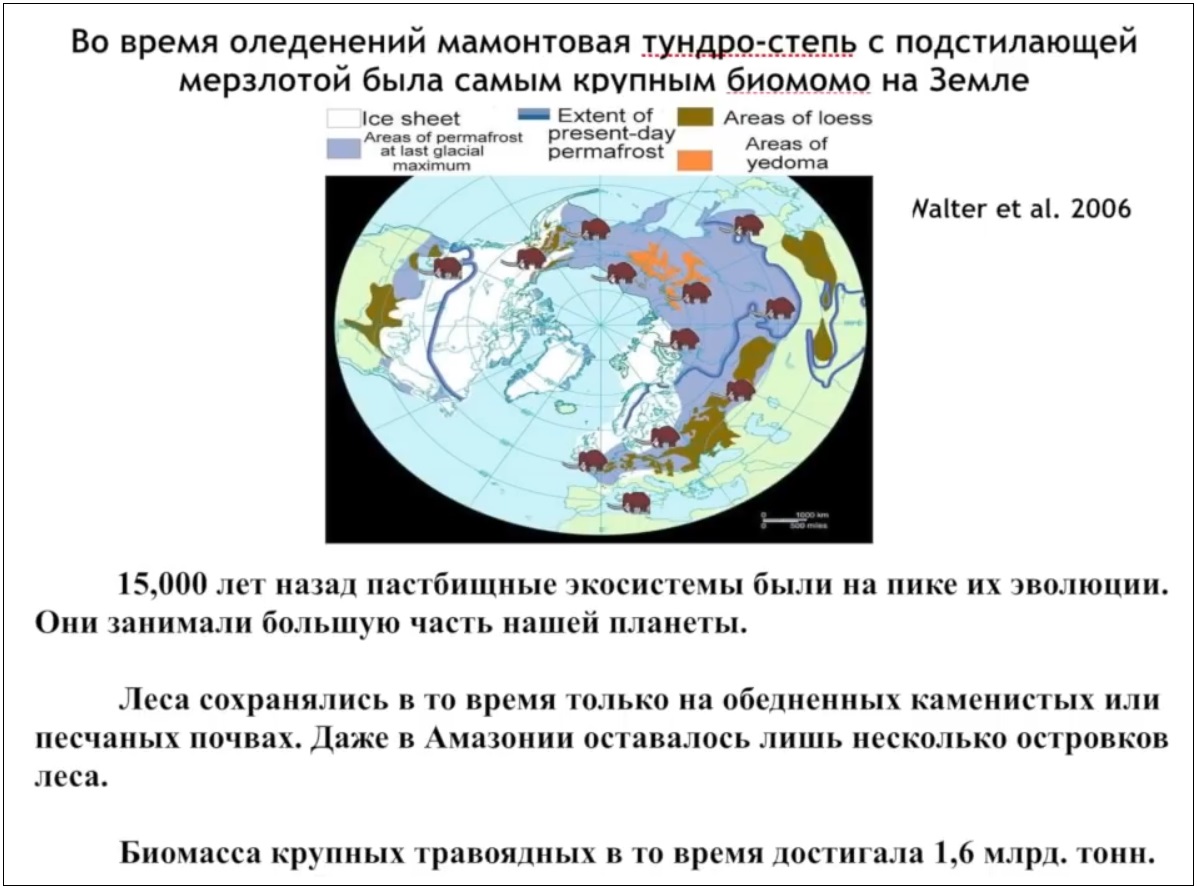
Captured the whole world.
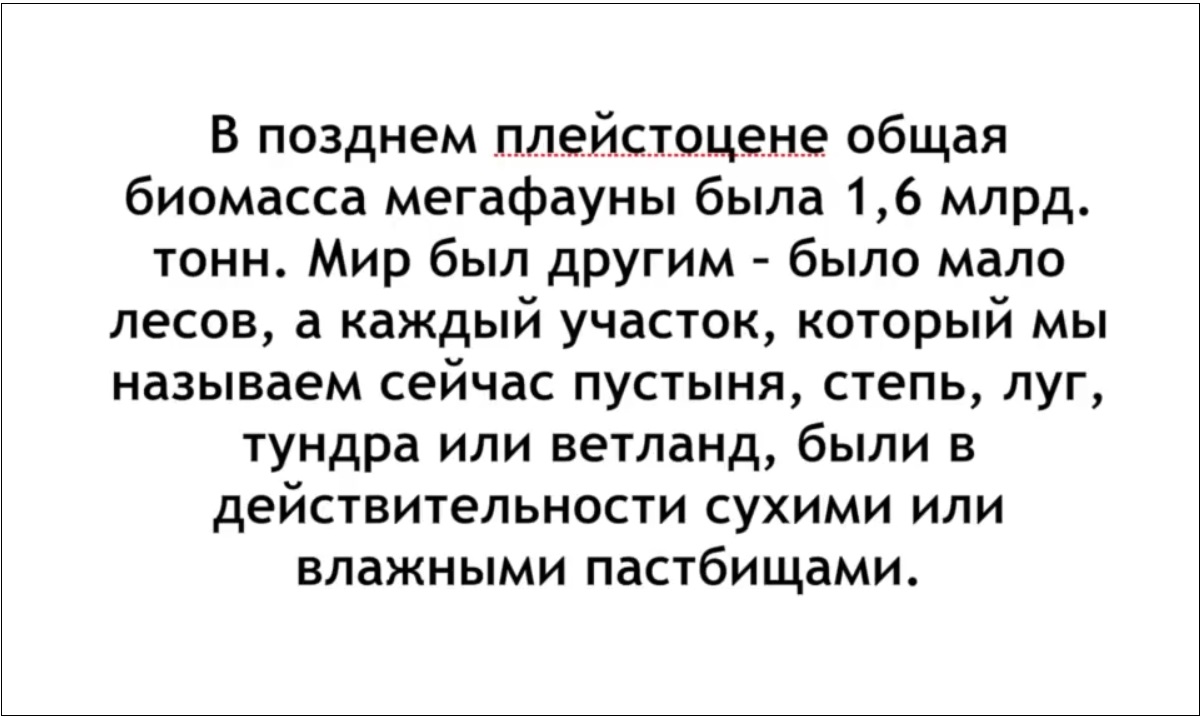
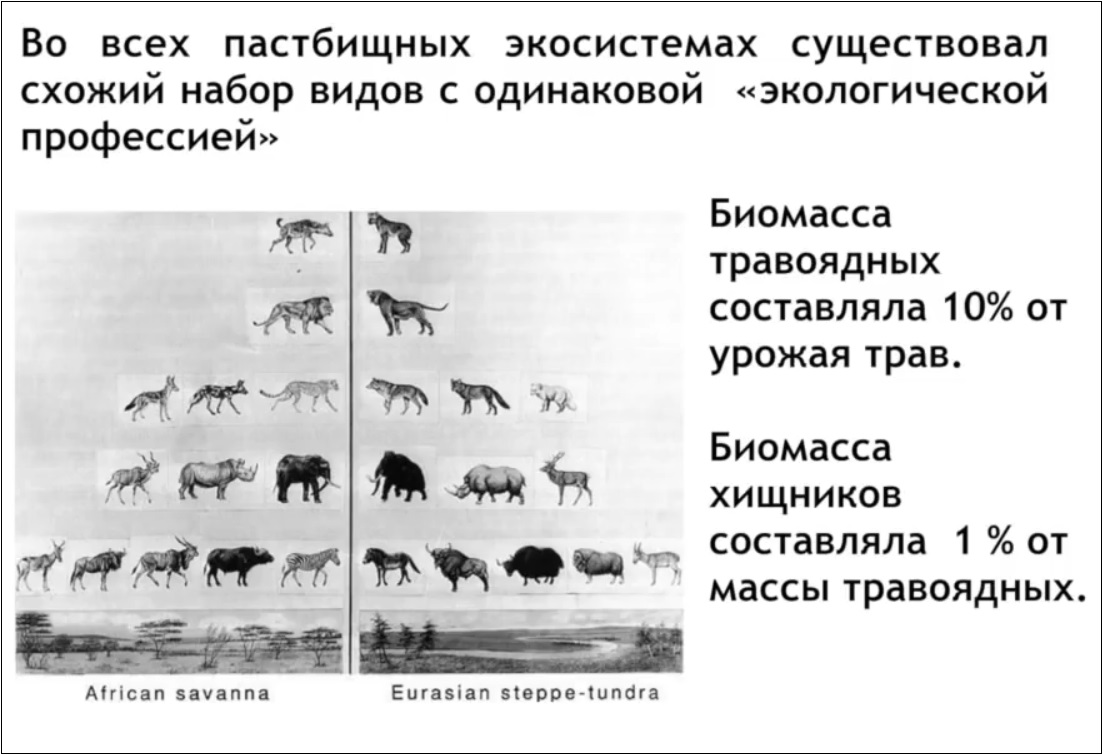
The task of the elephant / mammoth is to provide itself and the rest with water. Dig a hole, dig up the ice.
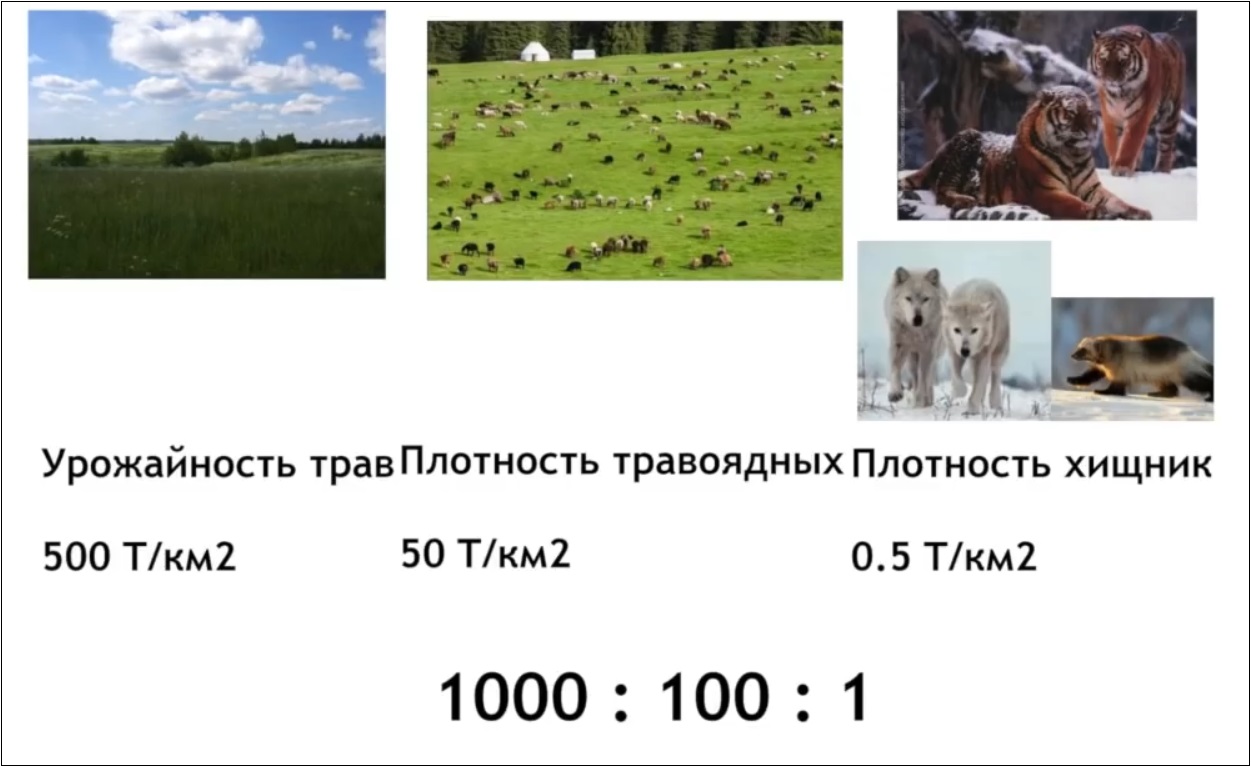
Let animals into the forest:

After a year:

Ate the whole bark.
2-3 years and mighty forests disappear. Mammoths are not needed, deer cope.
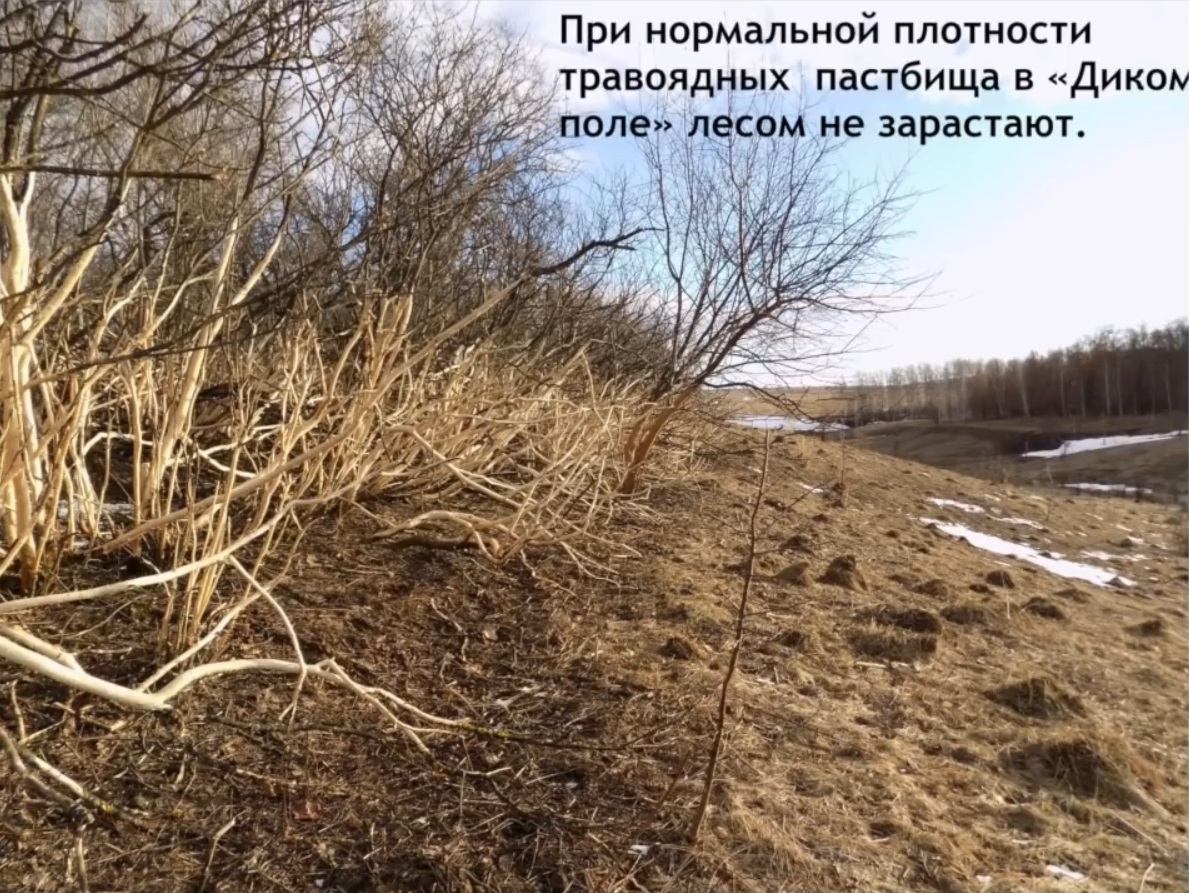
There is no bark at all. The ecosystem is over-aggressive. All plow, cut, download, burn.
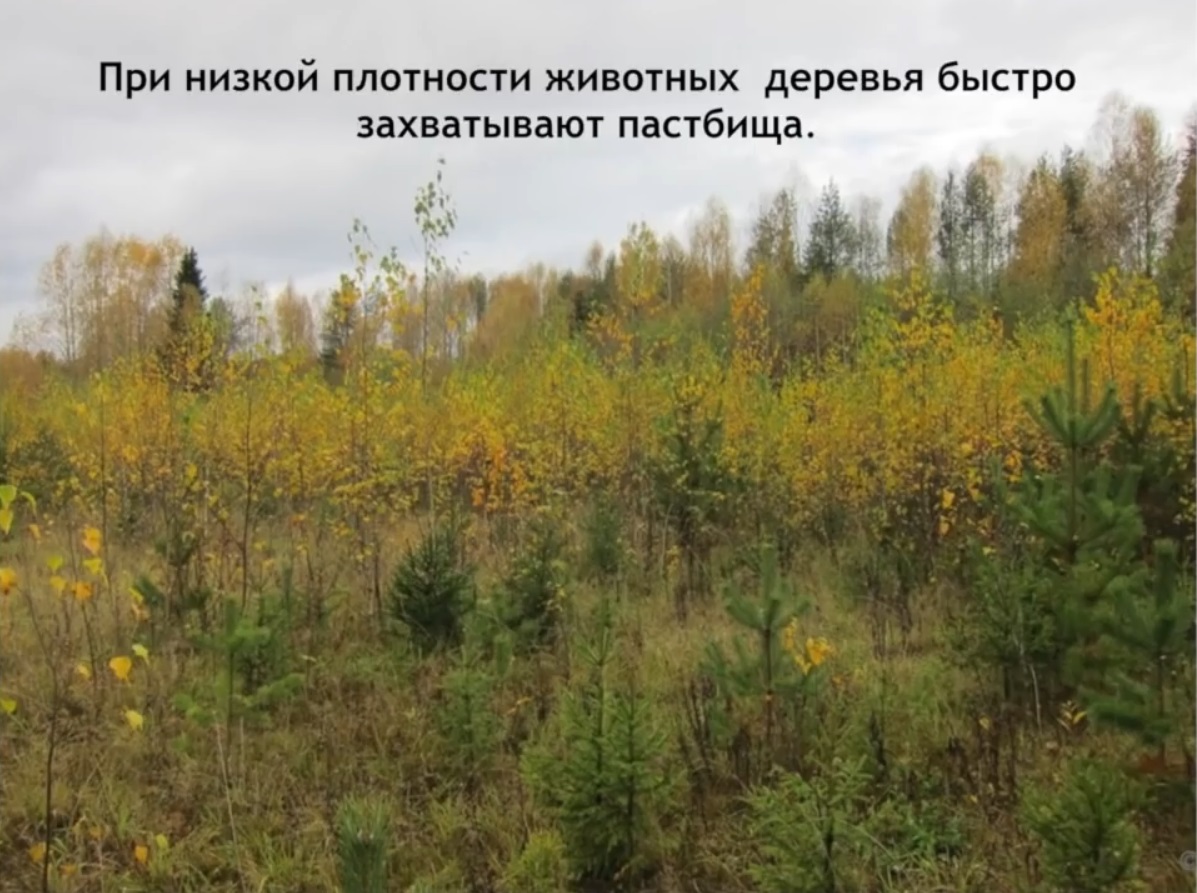
In the absence of animals - everything is covered with trees.
Alan Savori advocates that moderate grazing promotes grass overgrowth. A couple of slides from his presentation. This is Africa already.
It was:
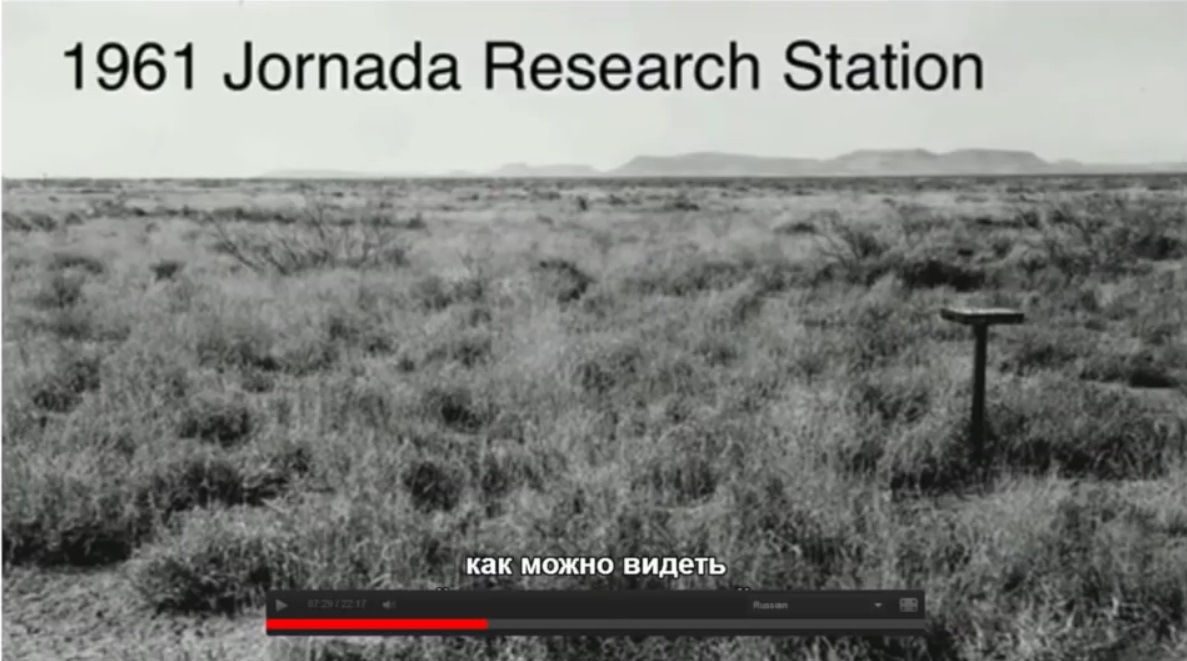
It was:
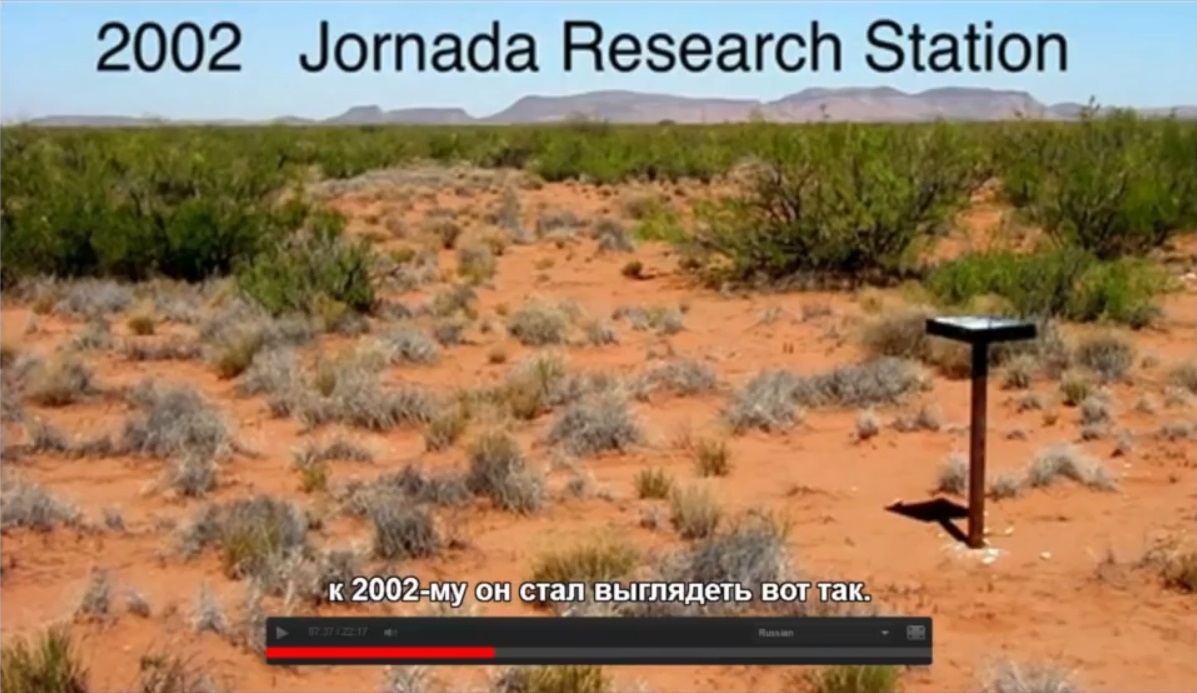
It was:
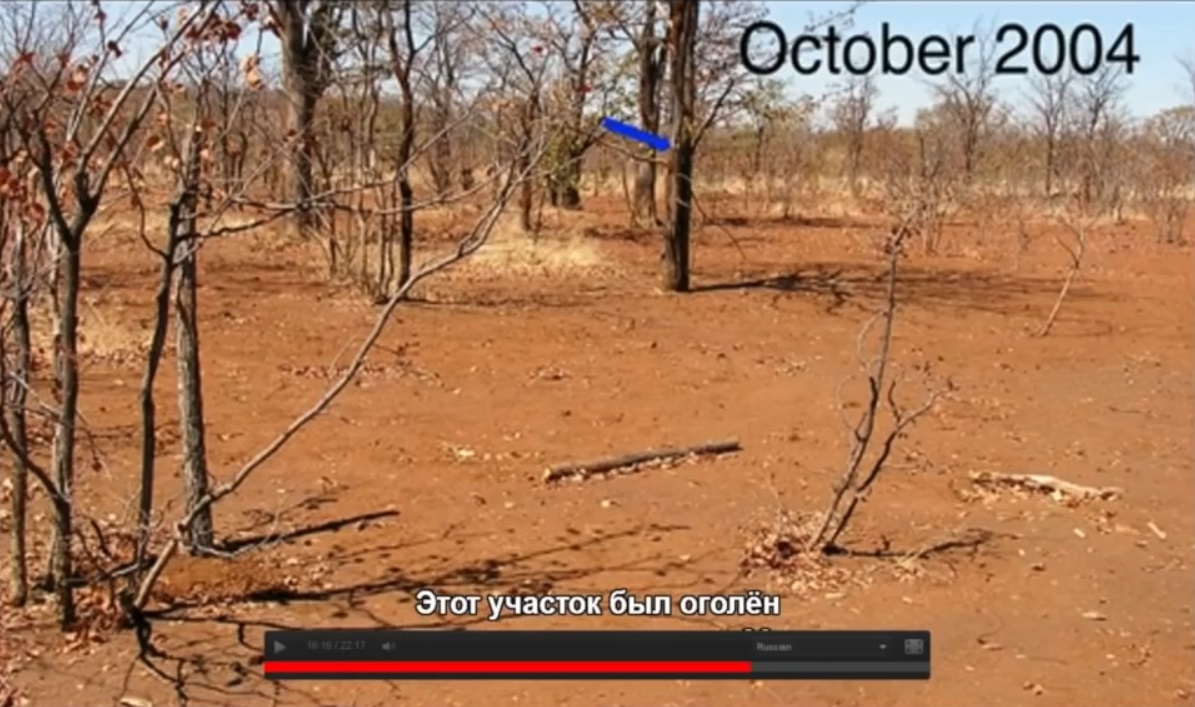
It
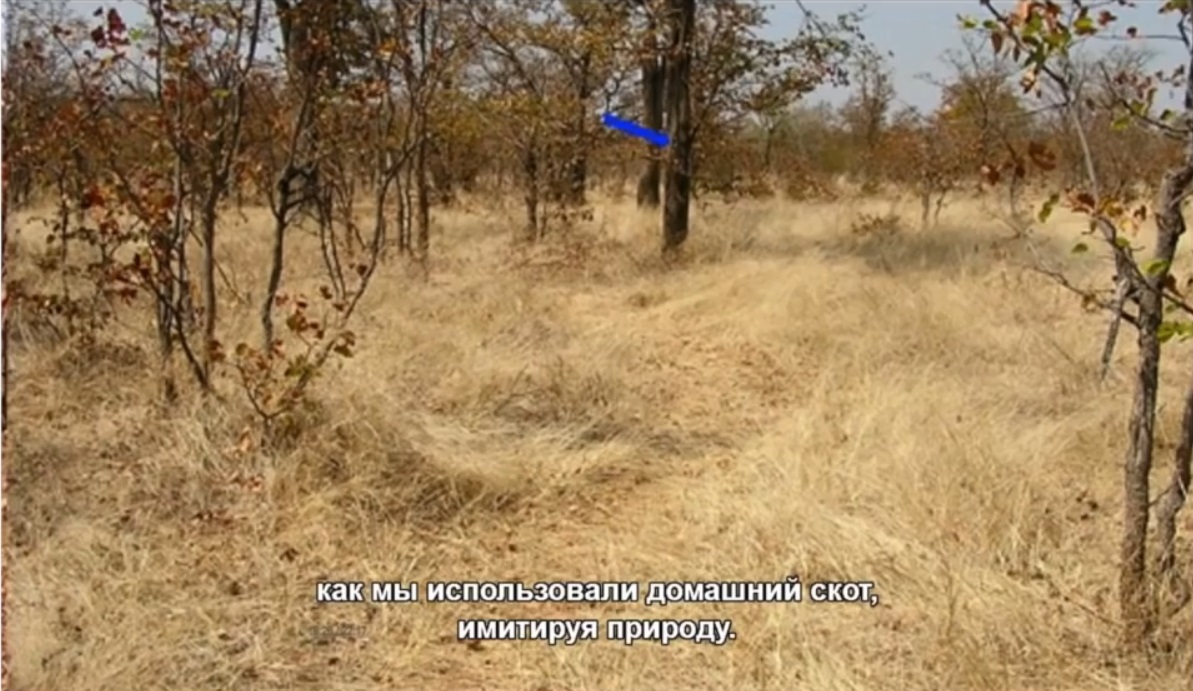
was:

It
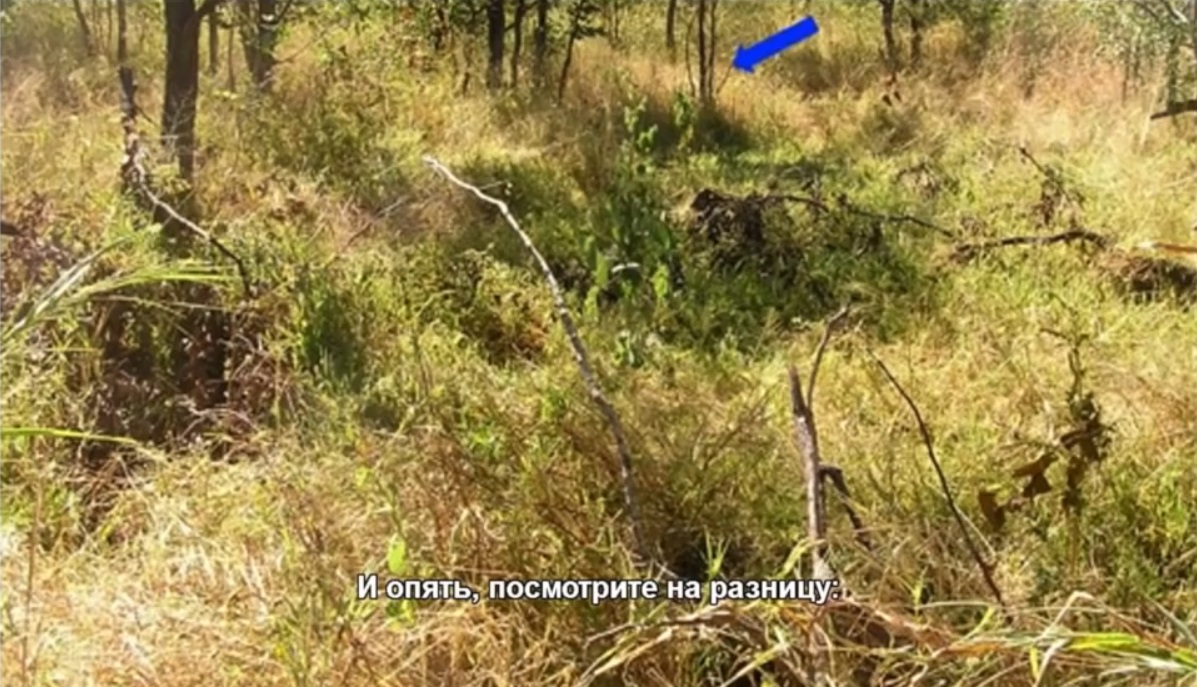
was:
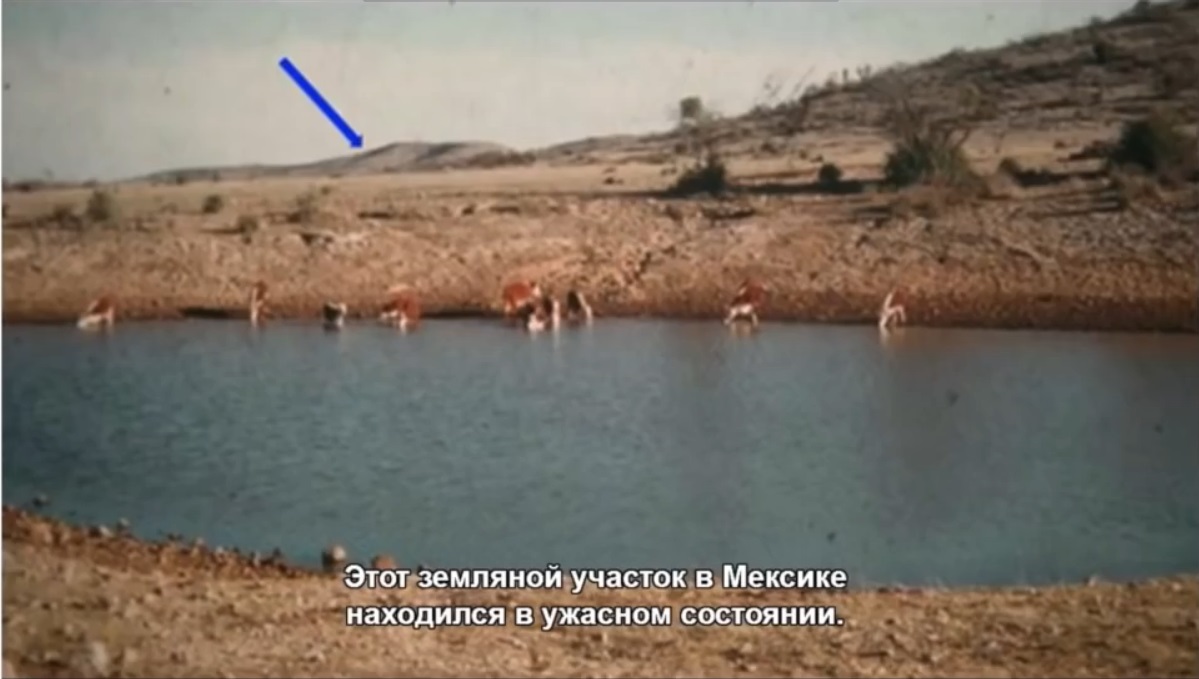
It was: It was: It was: It was: It was:
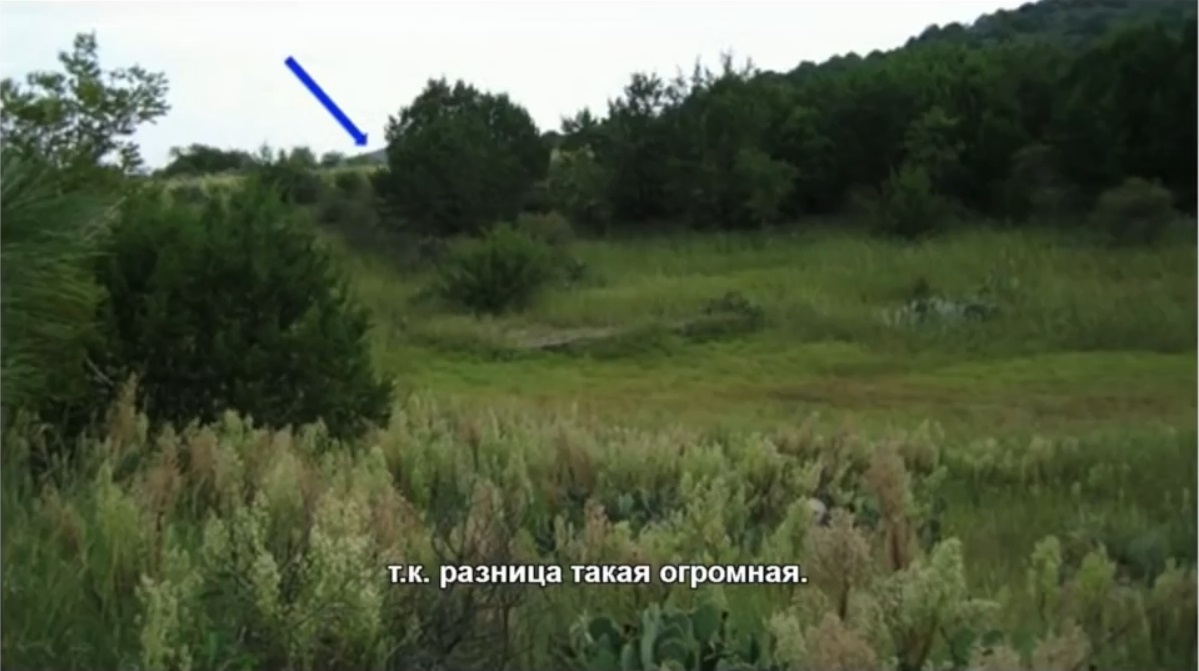
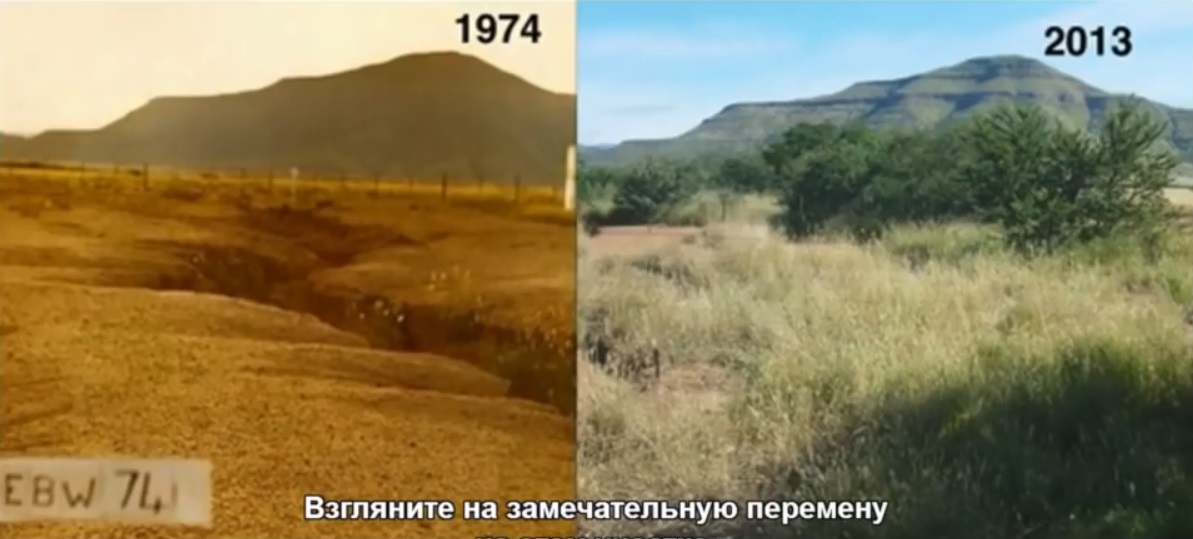
Let's go back from Africa to the general questions.
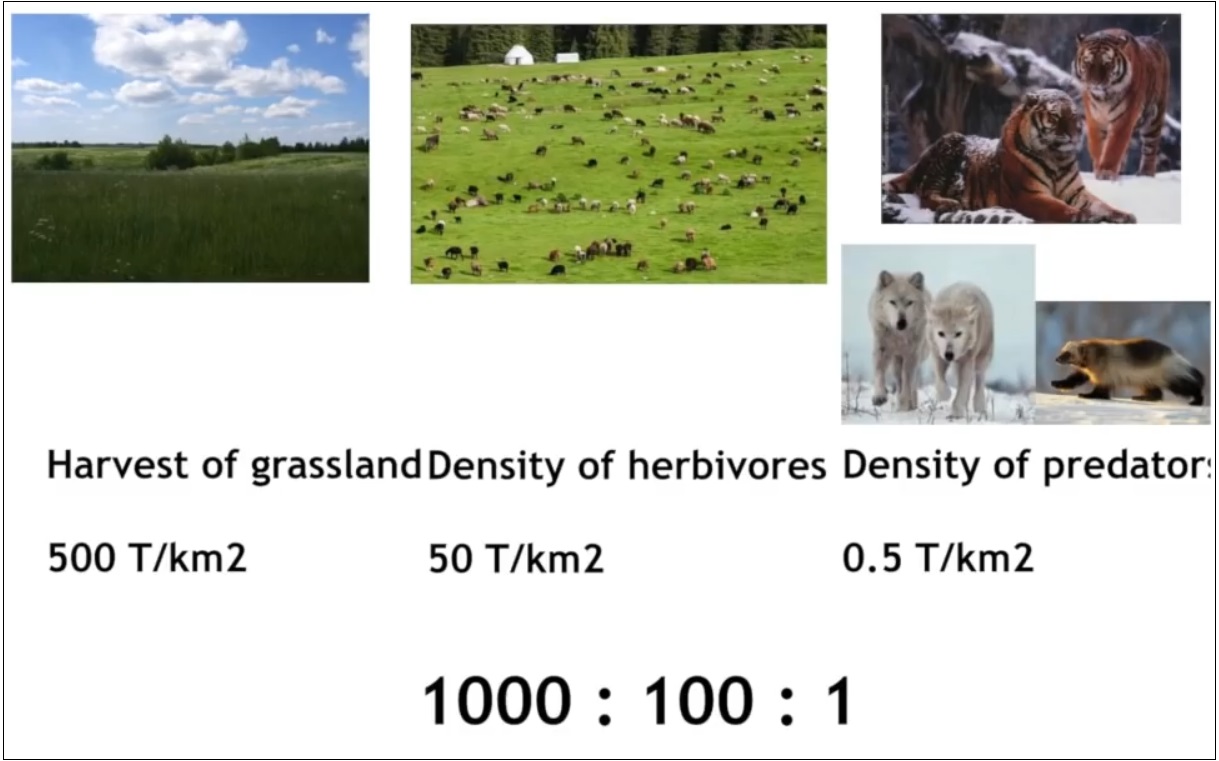
How to hunt a predator in such a situation? Full confusion.
With such productivity, there are 2-3 large cats, 2-3 wolves, one wolverine, 2 ferrets, 1 vulture, 6 ravens per square kilometer. To dial half a ton. How to make the biocycle stable at such a high density?
There must be a complex social organization.

Each predator has its own territory, there is no problem to eat, there is no need to hunt. If you protect your herd, the children will survive. They didn’t eat their cattle thoughtlessly, sometimes alien, sometimes nomadic “lost”.
A good host will never cut the best chicken, a pig. They are a tribe. Wolves do not slaughter cattle in the summer. Eat mice, bunnies, lizards. Cattle as needed, in the fall. Skotina also “understood” this. While I'm with the owner, he will not touch me.
If someone started to “blame”, then they will definitely bite him, because otherwise the neighbor will bite him.
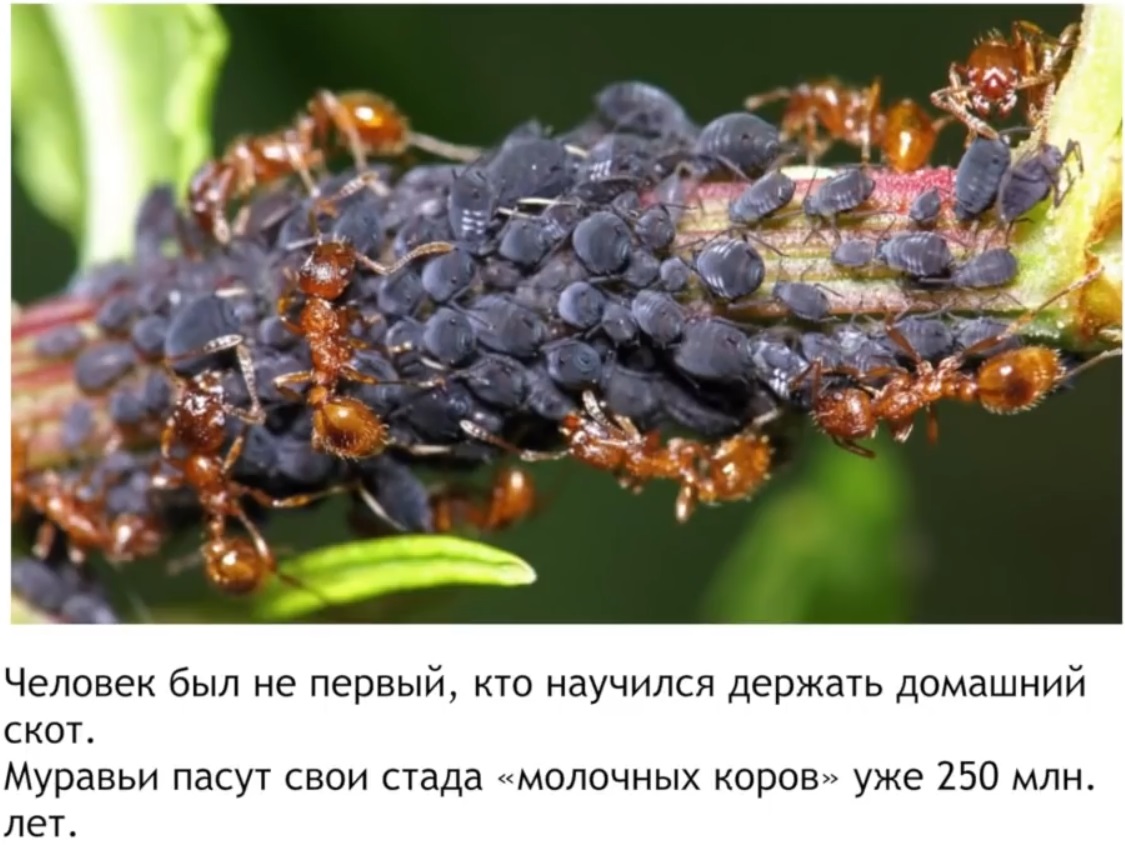
In the wild, a social contract. You act like that, we are like that, no one is impudent. We ourselves will give the sick and loonies to predators.
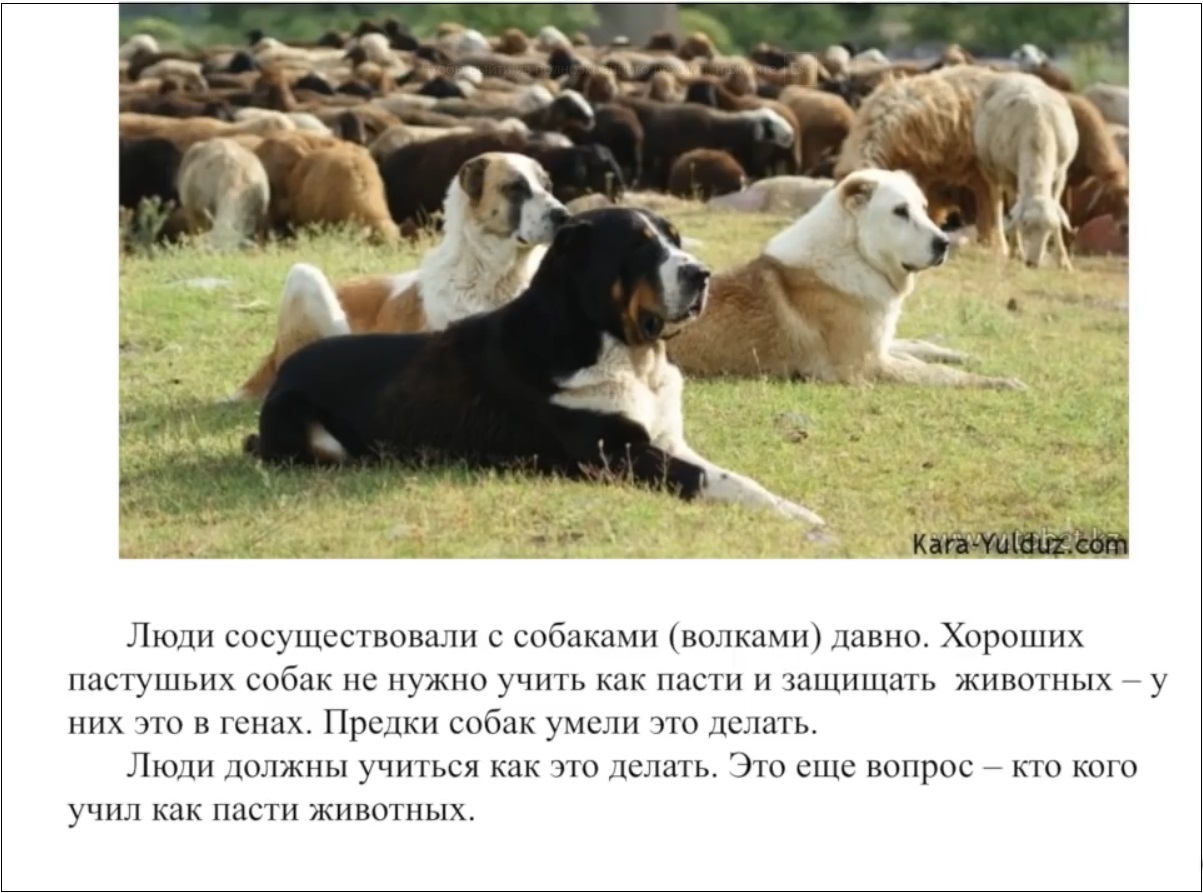
Wolves graze herds for millions of years. This dog taught people to graze herds.

How did people survive? Being the slowest and weakest. Having so many children. How did animals survive with such an amount, including predators?

Wolf family: 10 puppies are born every year. A year has passed - the puppies are already hunters. In humans - 1 child per year, after 15 more or less learned to move, became a hunter after 20. A pack of wolves can take risks.

The man did not hunt.

A guarantee of survival - if you have your own chip, when you can do something that no one can take away.
Onion - 20% sugar.
If the onions, horseradish, garlic, do not exterminate - they will clog all the pastures. There must be "cleaners." Only a person can eat this rubbish. And then a fire appeared. 450,000 years ago.
The man was a pasture cleaner and no one offended him. Smelly, nasty, but let him live.
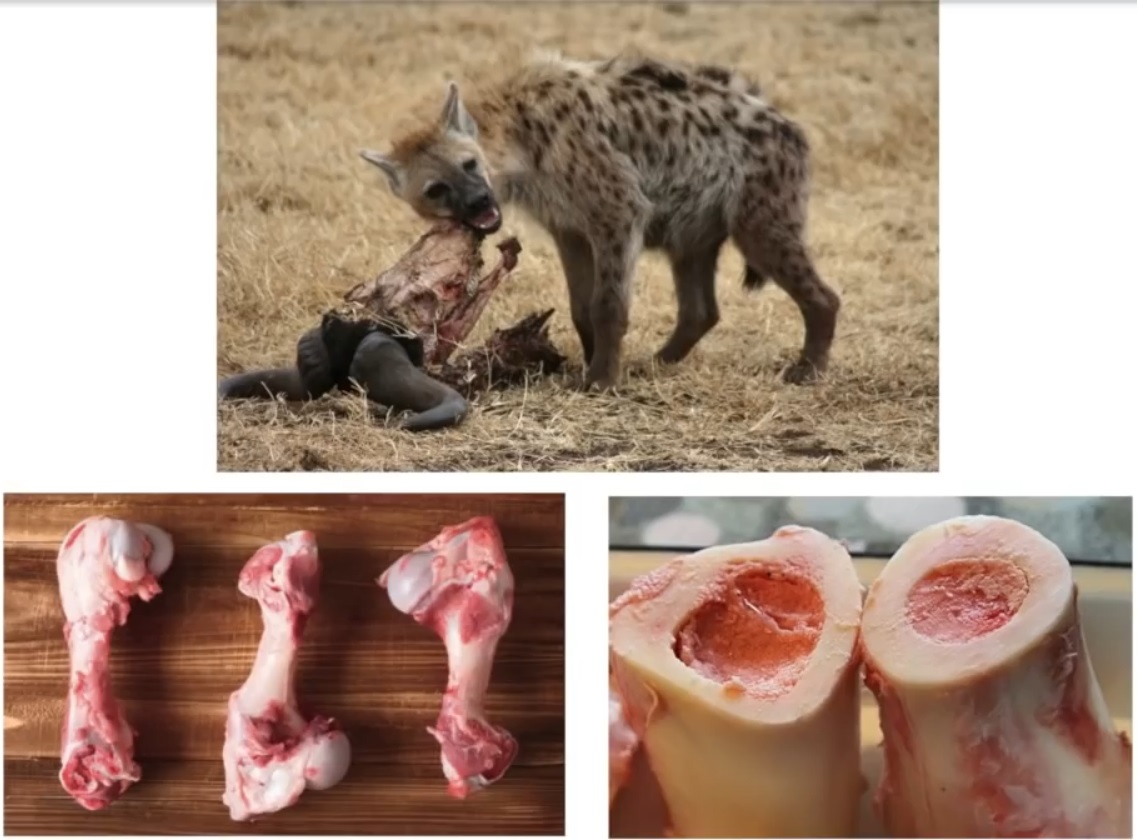
When the bison was heaped up, everyone ate and even all the crows scattered, the "boys" dragging the tibia, radius, skull and home by rushing. At home, in the hole, the bone was dismantled and eaten the most delicious. Only a person can easily crack bones.
The man had two food niches, where he was the king - the bones of large animals, and large animals in the radius of view died every day. Plus smelly and bitter roots.

The man was untouchable. Thanks to this, he survived. But then he developed into a weapon and already there he “recouped”.
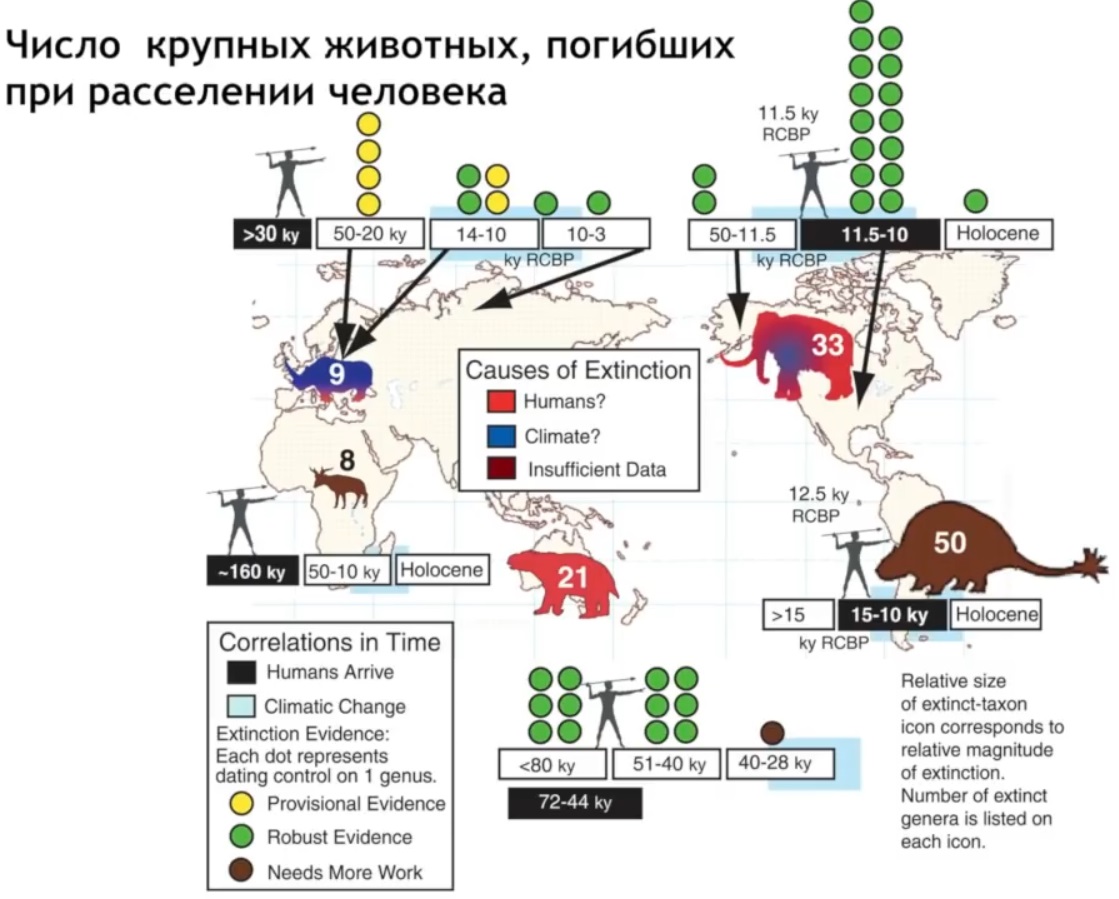
In Africa - 8, in Eurasia, 9 species of large animals were exterminated, in North America - 33.
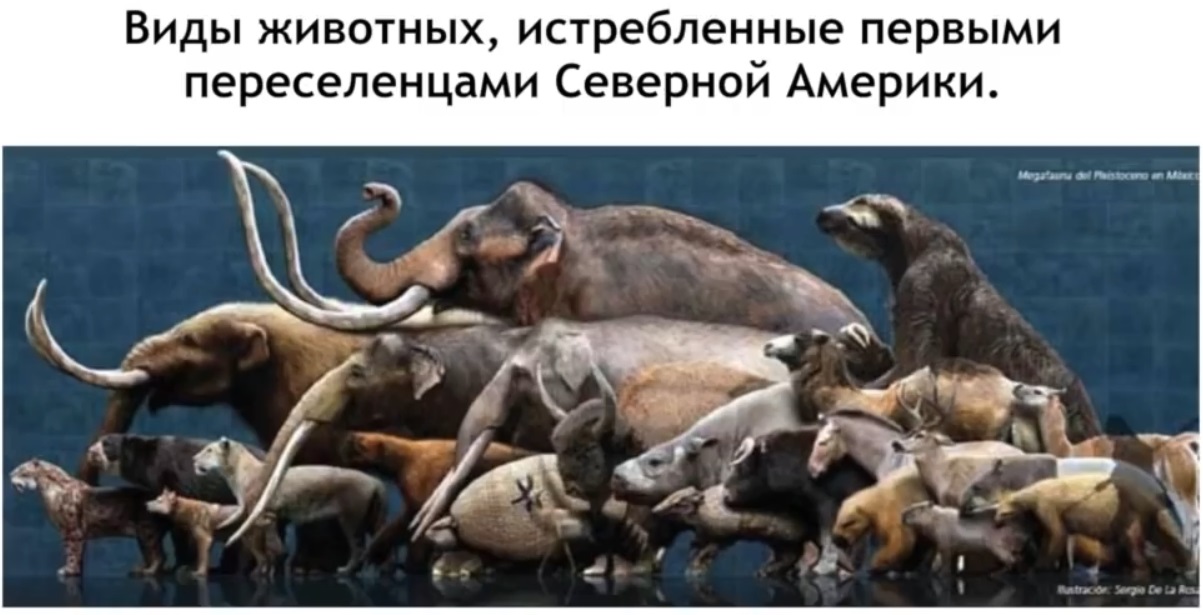
Some elephants in North America were 4 species - they all “soaked” them.
What large animals do you know in South America? None. Only mediocre llama and tapir. But there were plenty of Big ones before. Man exterminated everyone. And in Australia he exterminated everyone (21 species), only a kangaroo survived.
Przhevalsky killed all the animals he saw.
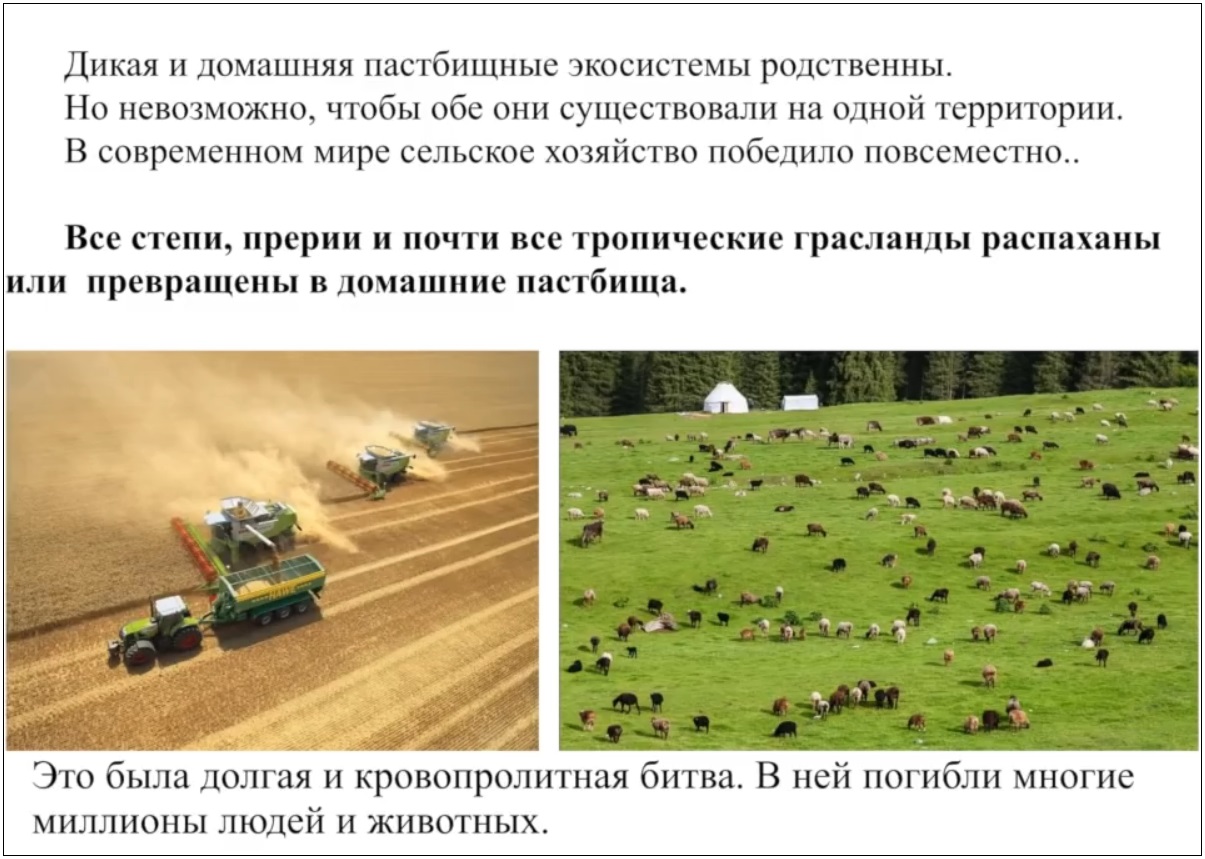
Man began to make new, managed pasture ecosystems. The first people to kill were large cats that defended “their” herds. They survived in dense forests, inaccessible mountains, in a waterless desert.
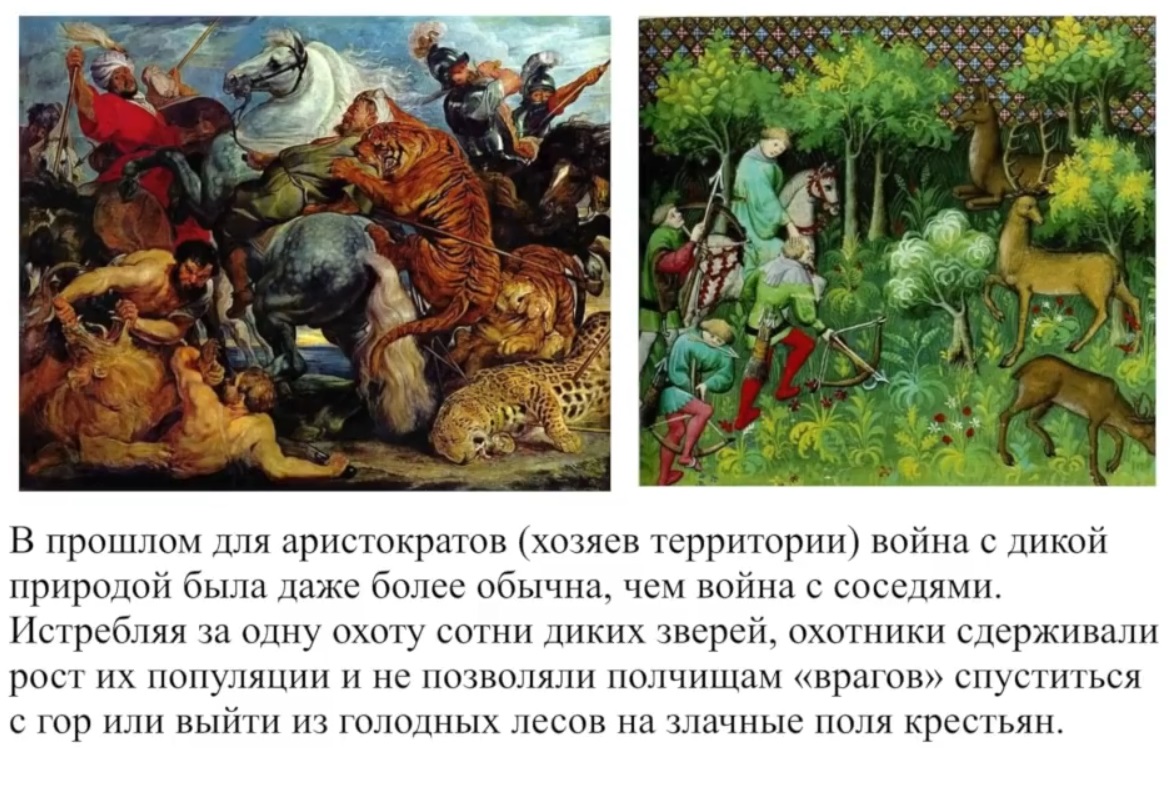
Man fiercely fought with the wild.


A million whales died. Each of 100 tons.
50 million bison killed 500 hunters in 10 years.
===
Before the advent of man, there was "military democracy." All were armed. with the advent of hegemon - the dictatorship of the proletariat.
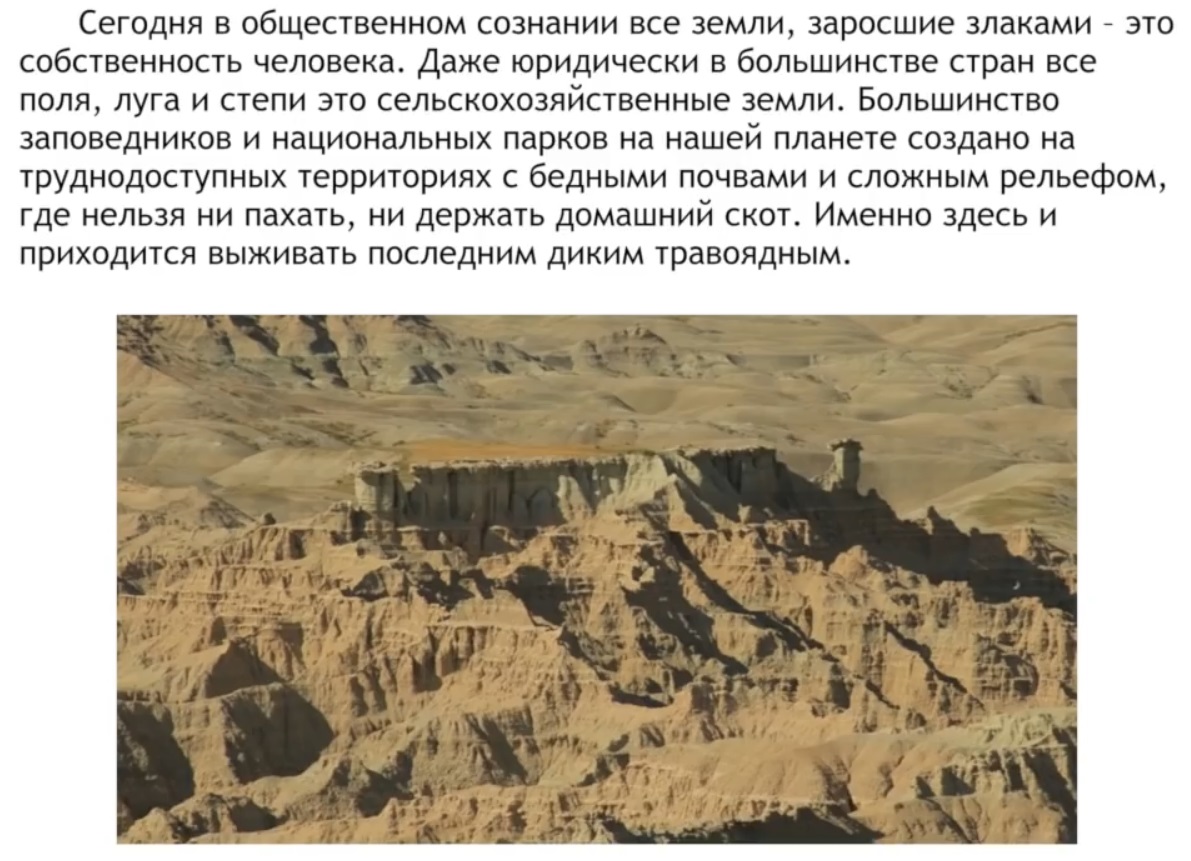
We practically do not know any other nature than the forest.

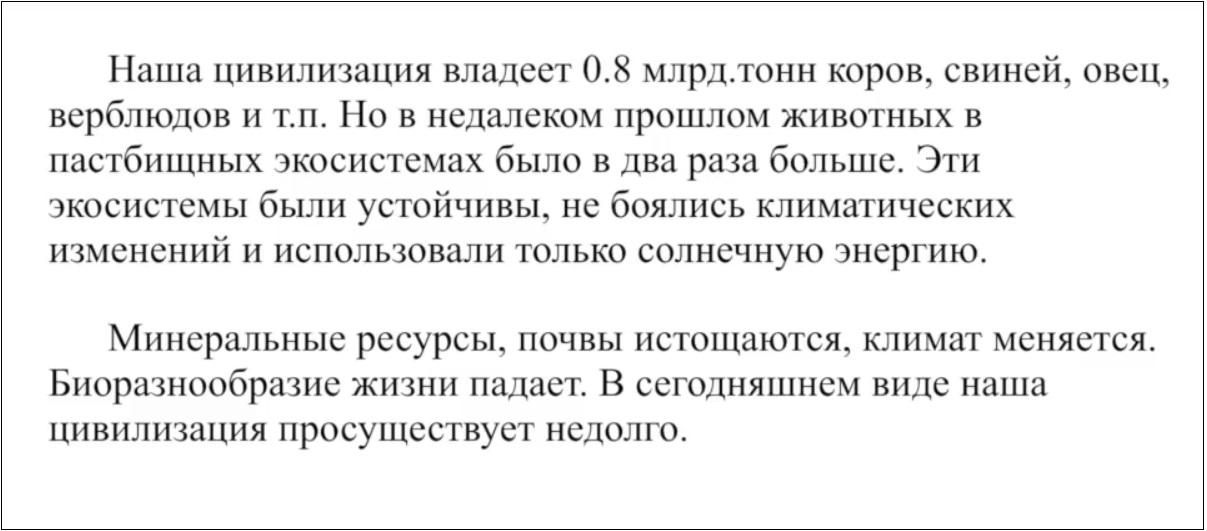

Our civilization is based on readily available oil. Available oil will end - and it will be necessary to come up with something new.
The most valuable thing is the gene pool. He gained millions of years, and losing it is easy.
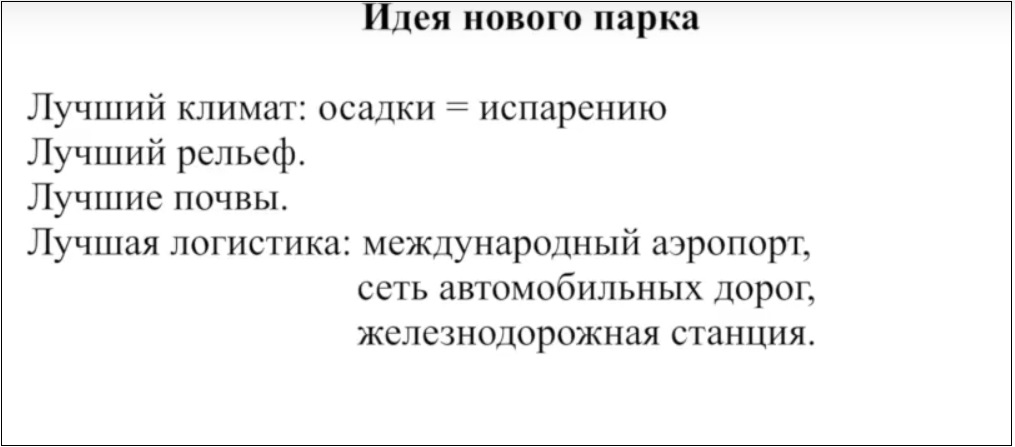
And let's repay the debt to nature. Let's make a natural park not in the most wretched, but in the most convenient place.
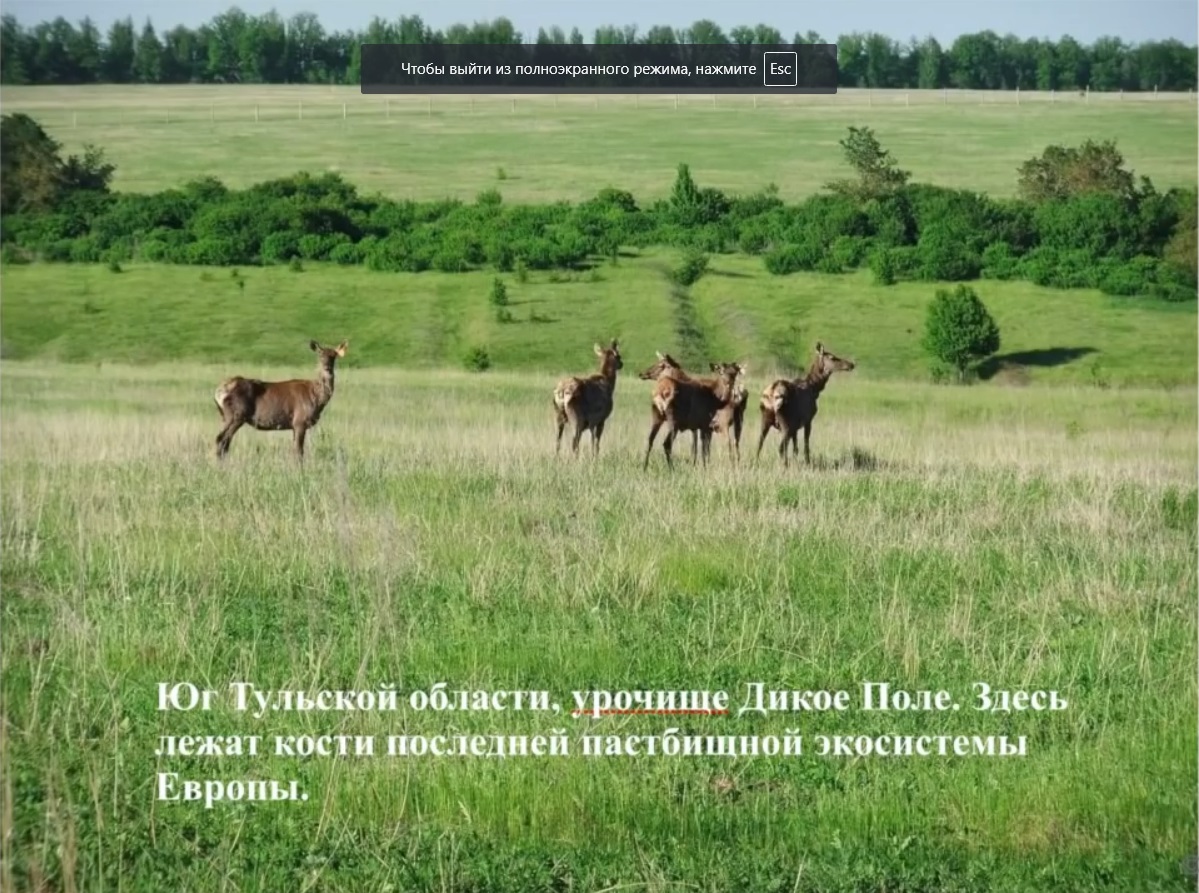


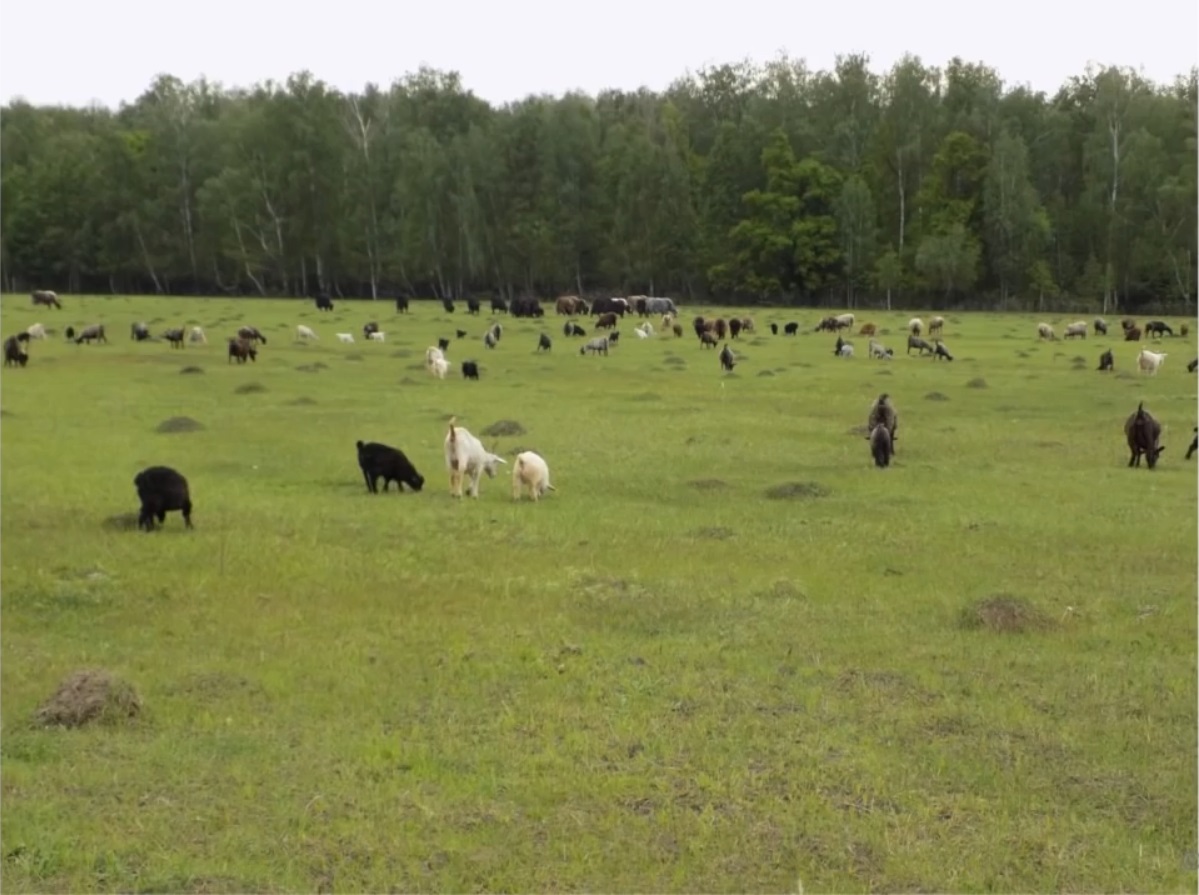
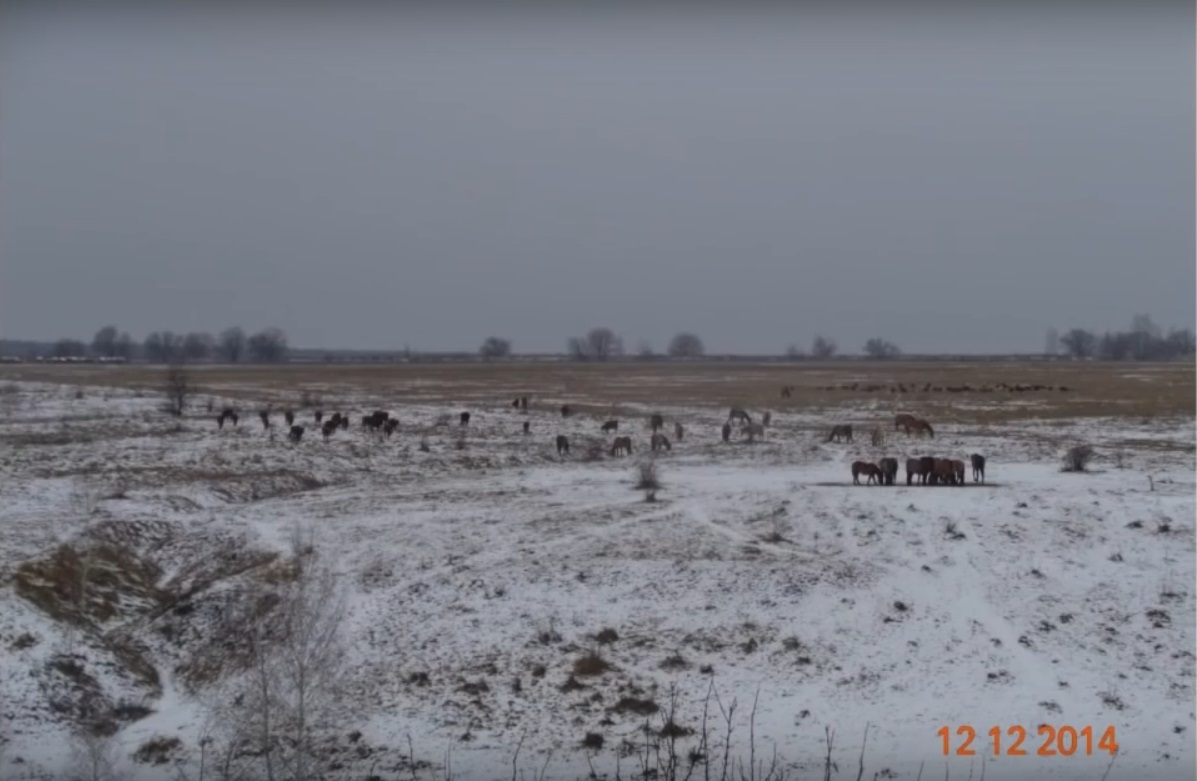


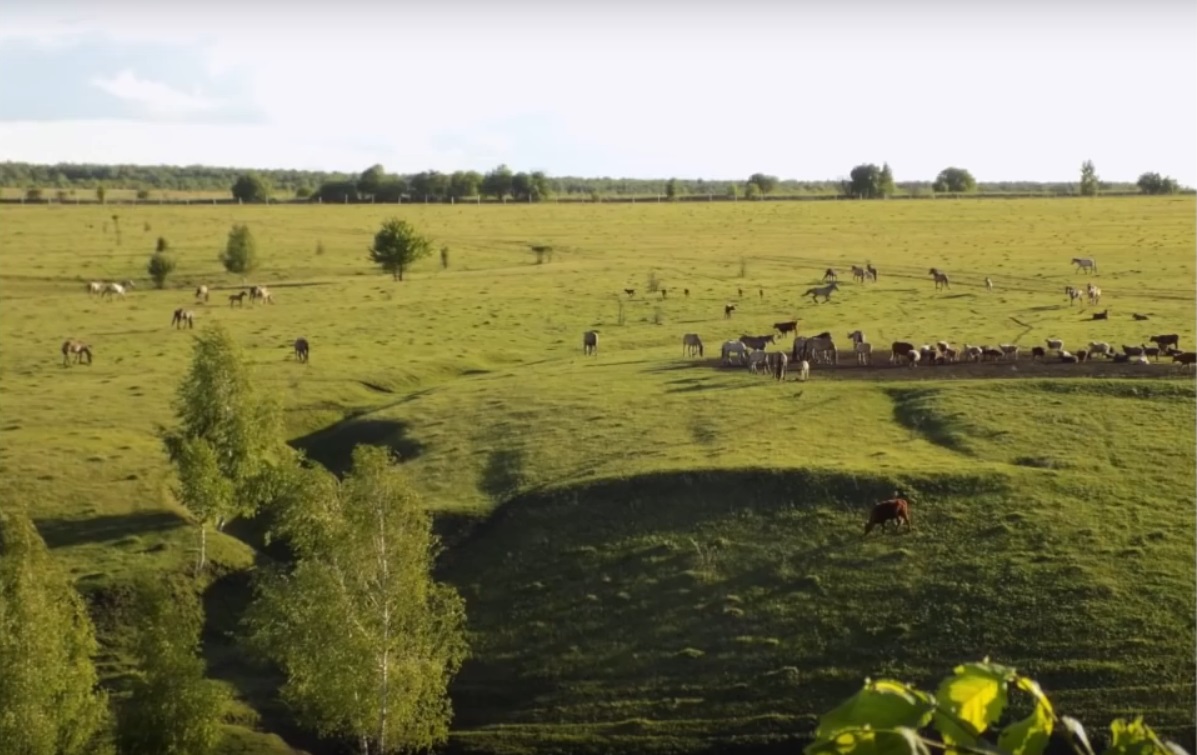
I bought land, built a fence, brought cattle - the system worked.
Now tens of millions of hectares of fields are overgrown.
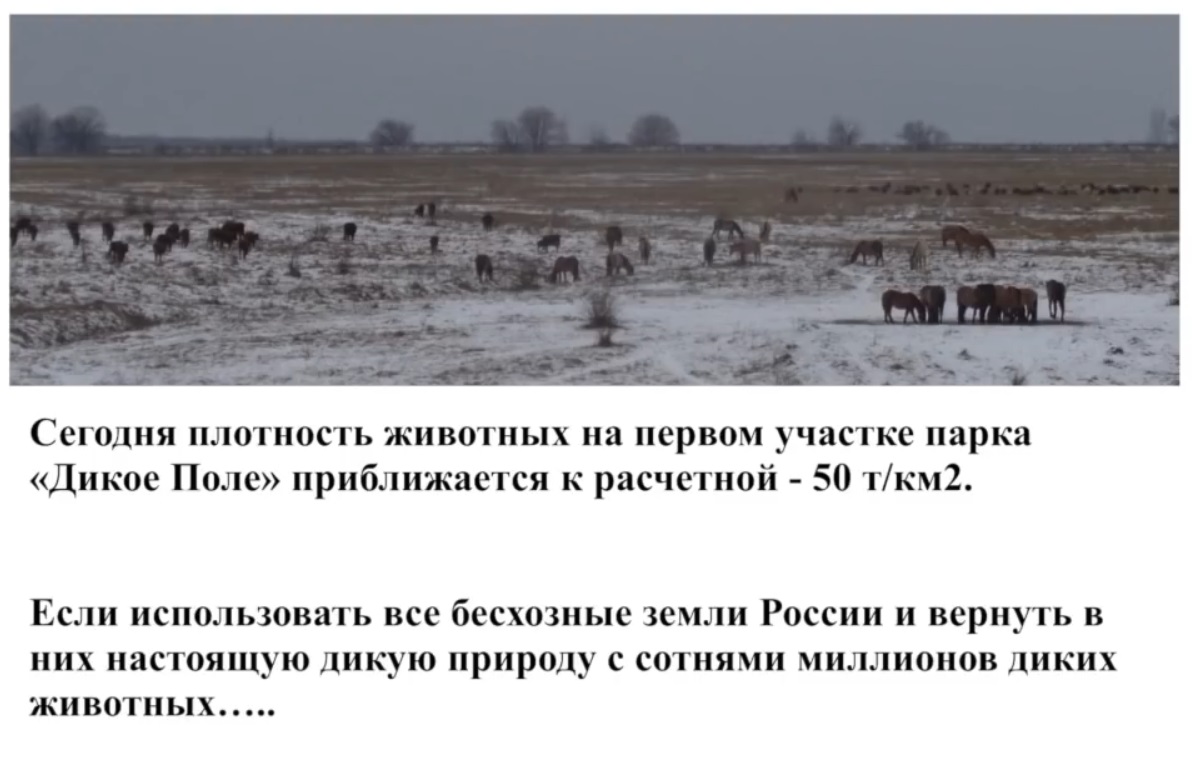

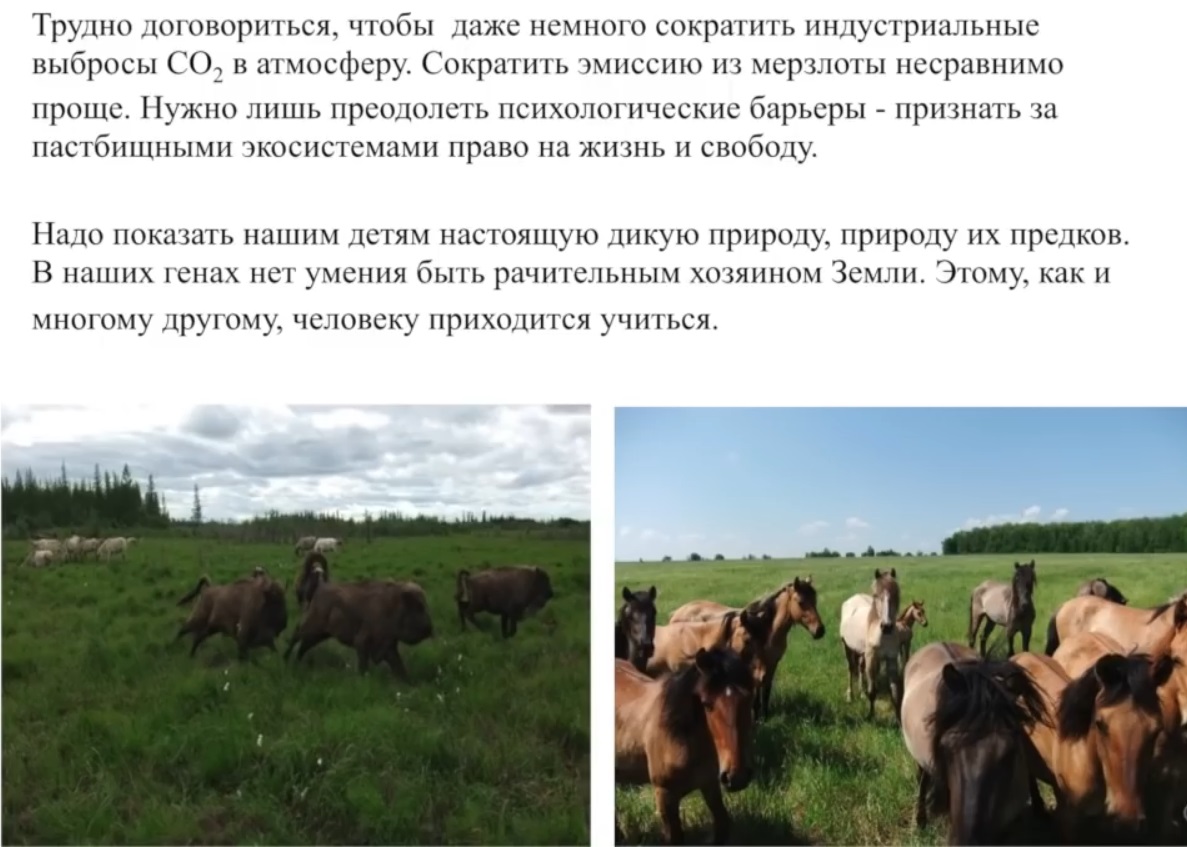
Contacts
mass media
- Mammoth House
- A good fence is the main condition for the restoration of the mammoth steppes
- Ice Age Park
- A unique scientific experiment, begun in Yakutia more than 30 years ago, continues
- Welcome to Pleistocene Park: The mammoth plan to recreate an ice age ecosystem in Siberia
- Pleistocene Park: Return of the Mammoth's Ecosystem
PS
Scientific publications
- Zimov S.A., G.M.Zimova, S.P.Daviodov, A.I.Daviodova, Y.V.Voropaev,
Z.V.Voropaeva, S.F.Prosiannikov, O.V.Prosiannikova, I.V.Semiletova, I.P.Semiletov. Winter biotic activity and production of CO2 in Siberian soils: a factor in the greenhouse effect. Jour. Geophys. Res., 1993, 98, 5017- 5023. - Semiletov I.P., Zimov S.A., Voropaev Yu.V., Daviodov S.P., Barkov N.I., Gusev A.M., Lipenkov V.Ya. (1994) Atmospheric Methane in past and present. Trans, (Doklady) Russ. Acad. Sci. v. 339, n 2, p.253-256.
- Zimov, S. A., Chuprynin, V. I., Oreshko, A. P., Chapin III, F. S., Reynolds, J. F., and Chapin, M. C. (1995) Steppe-tundra transition: a herbivore-driven biome shift at the end of the pleistocene. American Naturalist. 146:765-794.
- Zimov, S.A., V.I. Chuprynin, A.P. Oreshko, F.S. Chapin, III, M.C. Chapin, and J.F. Reynolds. 1995. Effects of mammals on ecosystem change at the Pleistocene-Holocene boundary. Pages 127-135 In: F. S. Chapin, III, and Ch. Körner, eds. Arctic and Alpine Biodiversity: Patterns, Causes and Ecosystem Consequences. Springer-Verlag, Berlin.
- Chapin, III, S.A. Zimov, G.R. Shaver, and S.E. Hobbie. 1996. CO2 fluctuation at high latitudes. Nature 383: 585-586.
- Zimov, S.A., S.P. Davidov, Y.V. Voropaev, S.F. Prosiannikov, I.P. Semiletov, M.C. Chapin, and F.S. Chapin, III. 1996. Siberian CO2 efflux in winter as a CO2 source and cause of seasonality in atmospheric CO2. Climatic Change 33:111-120
- Semiletov I.P., Pipko I.I., Pivovarov N.Ya., Popov V.V., Zimov S.A., Voropaev Yu.V., and S.P.Daviodov (1996) Atmospheric carbon emission from North Asian Lakes: a factor of global significance. Atmospheric Environment 30: 10⁄11, p.1657-1671.
- Zimov, S.A., Y.V. Voropaev, I.P. Semiletov, S.P. Davidov, S.F. Prosiannikov, F.S. Chapin, III, M.C. Chapin, S. Trumbore, and S. Tyler. 1997. North Siberian lakes: a methane source fueled by Pleistocene carbon. Science 277:800-802.
- Zimov, G.M. Zimova, M.C. Chapin, and J.F. Reynolds. 1999. Contribution of disturbance to high-latitude amplification of atmospheric CO 2. Bull. Ecol. Soc. Amer.
- Zimov, S.A., Davidov, S.P., Zimova, G.M., Davidova, A.I., Chapin, F.S., III, Chapin, M.C. and Reynolds, J.F. 1999. Contribution of disturbance to increasing seasonal amplitude of atmospheric CO2. Science 284: 1973-1976.
- Chapin, F.S. III., McGuire, A.D., Randerson, J., Pielke, Sr., R., Baldocchi, D., Hobbie, S.E., Roulet, N., Eugster, W., Kasischke, E., Rastetter, E.B., Zimov, S.A., Oechel, W.C., and Running, S.W. 2000. Arctic and boreal ecosystems of western North America as components of the climate system. Global Change Biology 6: S211-S223.
- Zimov, S.A., Y.V. Voropaev, S.P. Davydov, G.M. Zimova, A.I. Davydova, F.S. Chapin, III, and M.C. Chapin. 2001. Flux of methane from North Siberian aquatic systems: Influence on atmospheric methane. Pages 511-524 In: R. Paepe and V. Melnikov (Eds.) Permafrost Response on Economic Development, Environmental Security and Natural Resources. Kluwer Academic Publishers, The Hague.
- Чупрынин В.И., Зимов С.А., Молчанова Л.А. Моделирование термического режима почвогрунтов с учетом биологического источника тепла// Криосфера Земли. 2001. Т.5. №1. С. 80-87
- B. Shapiro, A. Drummond, A. Rambaut, M. Wilson, P. Matheus, A. Sher, O. Pybus, M.
T. P. Gilbert, I. Barnes, J. Binladen, E. Willerslev, A. Hansen, G. F., Baryshnikov, J. Burns, S. Davydov, J. Driver, D. Froese, C. R., Harington, G. Keddie, P. Kosintsev, M. L. Kunz, L. D. Martin, R., Stephenson, J. Storer, R. Tedford, S. Zimov, A. Cooper. Rise and Fall of the Beringian Steppe Bison. Science, 2004; 306: 1561-1565. - Федоров-Давыдов Д.Г., Давыдов С.П., Давыдова А.И., Зимов С.А., Мергелов Н.С., Остроумов В.Е., Сороковиков В.А., Холодов А.Л., Митрошин И.А… Пространственно-временные закономерности сезонного протаивания почв на севере Колымской низменности. Криосфера Земли, 2004, т.8, №4, с 15-26.
- Fyodorov-Davydov, D., V.Sorokovikov, V.Ostroumov, A.Kholodov, I.Mitroshin, N.Mergelov, S.Davydov, S.Zimov, A.Davydova. Spatial and temporal observations of seasonal thaw in the Northern Kolyma Lowland. Polar Geography. 2004, 28, 4, pp. 308-325
- F. Stuart Chapin III, Terry V. Callaghan, Yves Bergeron, M. Fukuda, J. F. Johnstone, G. Juday, and S. A. Zimov. Global Change and the Boreal Forest: Thresholds, Shifting States or Gradual Change? 2004. AMBIO: A Journal of the Human Environment: Vol. 33, No. 6, pp. 361–365.
- Zimov S.A. Pleistocene Park: Return of the Mammoth’s Ecosystem// Science, 2005, Vol. 308. P. 796-798.
- L. R. Welp, J. T. Randerson, J. C. Finlay, S. P. Davydov, G. M. Zimova, A. I. Davydova, and S. A. Zimov. A high-resolution time series of oxygen isotopes from the Kolyma River: Implications for the seasonal dynamics of discharge and basin-scale water use. Geophysical Research Letters, VOL. 32, L14401, doi:10.1029/2005GL022857, 2005.
- C. Corradi, O. Kolle, K. Walter, S. A. Zimov and E.-D. Schulze
Carbon dioxide and methane exchange of a north-east Siberian tussock tundra.
Global Change Biology (2005) 11, 1910–1925, doi: 10.1111/j.1365-2486.2005.01023.x. - K. M. Walter, S. A. Zimov, J. P. Chanton, D. Verbyla & F. S. Chapin III. 2006. Methane bubbling from Siberian thaw lakes as a positive feedback to climate warming. Nature 443, 71-75(7 September 2006) | doi:10.1038/nature05040.
- Sergey A. Zimov, Edward A. G. Schuur, F. Stuart Chapin III. 2006. Permafrost and the Global Carbon Budget. Science, Vol. 312, P.1612-1613.
- Zimov, S. A., S. P. Davydov, G. M. Zimova, A. I. Davydova, E. A. G. Schuur, K. Dutta, and F. S. Chapin, III (2006), Permafrost carbon: Stock and decomposability of a globally significant carbon pool, Geophys. Res. Lett., 33, L20502, doi:10.1029/2006GL027484. 5 p.
- Finlay J., J. Neff, S. Zimov, A. Davydova, and S. Davydov. Snowmelt dominance of dissolved organic carbon in high-latitude watersheds: Implications for characterization and flux of river DOC. Geophysical Research Letters, vol. 33, L14401, 2006
- Chapin, F. S., III, M. Hoel, S. R. Carpenter, J. Lubchenco, B. Walker, T. V. Callaghan, C. Folke, S. Levin, K.-G. Maler, C. Nilsson, S. Barrett, F. Berkes, A.-S. Crepin, K. Danell, T.Rosswall, D. Starrett, T. Xepapadeas, and S. A. Zimov. Building Resilience and Adaptation to Manage Arctic Change. AMBIO, 2006, Vol.35, No.4, June 2006.P.198-202.
- Koushik Dutta, A, E. A. G. Schuur, J. C. Neff and S. A. Zimov. Potential carbon release from permafrost soils of Northeastern Siberia Global Change Biology (2006) Vol. 12, Number 12, P. 2336–2351, doi: 10.1111/j.1365-2486.2006.01259.x
- Neff, J.C., J. Finlay, S.A. Zimov, S. Davydov, J.J. Carrasco, E.A.G. Schuur, A. Davydova. (2006) Seasonal changes in the age and structure of dissolved organic carbon in Siberian Rivers and streams. Geophysical Research Letters. 33(23), L23401, 10.1029/2006GL028222.
- K. M. Walter, M. E. Edwards, G. Grosse, S. A. Zimov, F. S. Chapin III (2007)
Thermokarst Lakes as a Source of Atmospheric CH4 During the Last Deglaciation
Science, VOL 318. P. 633-636. - D. V. Khvorostyanov,, G. Krinner, P. Ciais, M. Heimann and S. A. Zimov, Vulnerability of permafrost carbon to global warming. Part I: model description and role of heat generated by organic matter decomposition
(Manuscript received 3 November 2005; in final form 8 November 2007) Tellus (2008) B 15 pages. Tellus (Series B) 60, 250-264. - D. V. Khvorostyanov, P. Ciais, G. Krinner, S. A. Zimov, Ch. Corradi
and G. Guggenberger, Vulnerability of permafrost carbon to global warming.Part II: sensitivity of permafrost carbon stock to global warming
(Manuscript received 22 December 2006; in final form 8 November 2007) Tellus (2008) B 11 pages. - Khvorostyanov, D. V., P. Ciais, G. Krinner, and S. A. Zimov (2008), Vulnerability of east Siberia’s frozen carbon stores to future warming, Geophys. Res. Lett., V. 35, Issue 10, L10703, doi:10.1029/2008GL033639 20 May 2008
- K. M. Walter, J. P. Chanton, F. S. Chapin III, E. A. G. Schuur, S. A. Zimov. 2008. Methane production and bubble emissions from arctic lakes: Isotopic implications for source pathways and ages J. Geophys. Res., 113, G00A08, doi:10.1029/2007JG000569
- Schuur, E.A.G, J. Bockheim, J. Canadell, E. Euschkirchen, C. Field, S. Goryachkin, S. Hagemann, P.
Kuhry, P. Lafleur, H. Lee, G. Mazhitova, F. Nelson, A. Rinke, V. Romanovsky, N.
Shiklomanov, C. Tarnocai, S. Venevsky, J. G. Vogel, S.A. Zimov The vulnerability of permafrost carbon to climate change: implications for the global carbon cycle. BioScience
September 2008, Vol.58, No 8. P. 701-714. - McClelland, J. W., R. M. Holmes, B. J. Peterson, R. Amon, T. Brabets, L. Cooper, J. Gibson, V. V. Gordeev, C. Guay, D. Milburn, R. Staples, P. A. Raymond, I. Shiklomanov, R. Striegl, A. Zhulidov, T. Gurtovaya, and S. Zimov. 2008. Development of a pan-Arctic database for river chemistry.
EOS, Transactions, American Geophysical Union, 89:217-218. - Guido Grosse, Vladimir Romanovsky, Katey Walter, Anne Morgenstern, Hugues Lantuit, Sergei Zimov. Thermokarst Lakes: High-Resolution Distribution and Temporal Changes at Three Yedoma Sites in Siberia. Proceedings of NINTH INTERNATIONAL CONFERENCE ON PERMAFROST, P.551-556.
- Khalil, M. A. K., M. A. K. Khalil, C. L. Butenhoff, S. Zimov, K. M. Walter, J. M. Melack (2009), Correction to “Global methane emissions from wetlands, rice paddies, and lakes”, Eos Trans. AGU, 90(11), 92, 10.1029/2009EO110019.
- Zhuang, Q., J. M. Melack, S. Zimov, K. M. Walter, C. L. Butenhoff, and M. A. K. Khalil (2009), Global Methane Emissions From Wetlands, Rice Paddies, and Lakes, Eos Trans. AGU, 90(5), doi:10.1029/2009EO050001.
- Q. Zhuang, J. M. Melack, S. Zimov, K. M. Walter, C. L. Butenhoff, and M. A. K. Khalil
Global Methane Emissions From Wetlands, Rice Paddies, and Lakes. Eos, Vol. 90, No. 5, 3 February 2009. P. 37-38. - Zimov N. S., S. A. Zimov, A. E. Zimova, G. M. Zimova, V. I. Chuprynin, and F. S. Chapin III (2009), Carbon storage in permafrost and soils of the mammoth tundra-steppe biome: Role in the global carbon budget, Geophys. Res. Lett., 36, L02502, doi:10.1029/2008GL036332.
- 1. Zimov S., Implications of Ancient Ice. Science, 6 February 2009: Vol. 323. no. 5915, pp. 714 – 715.
- Tarnocai, C., J. G. Canadell, E.A.G. Schuur, P. Kuhry, G. Mazhitova, and S. Zimov (2009), Soil Organic Carbon Pools in the Northern Circumpolar Permafrost Region,Global Biogeochem. Cycles, Vol. 23, No. 2. (27 June 2009), GB2023.
- Levin, I., Naegler, T., Heinz, R., Osusko, D., Cuevas, E., Engel, A., Ilmberger, J., Langenfelds, R. L., Neininger, B., Rohden, C. v., Steele, L. P., Weller, R., Worthy, D. E., and Zimov, S. A.: Atmospheric observation-based global SF6 emissions – comparison of top-down and bottom-up estimates, Atmos. Chem. Phys. Discuss., 9, 26653-26672, 2009.
- Merbold L, Kutsch W.L., Corradi C., Kolle O., Rebmann C., Stoy P.C., Zimov Z.A. and Schulze E.-D. Artificial drainage and associated carbon fluxes (CO2/CH4) in a tundra ecosystem (2009) Global Change Biology, doi: 10.1111/j.1365-2426.2009.01962.x
